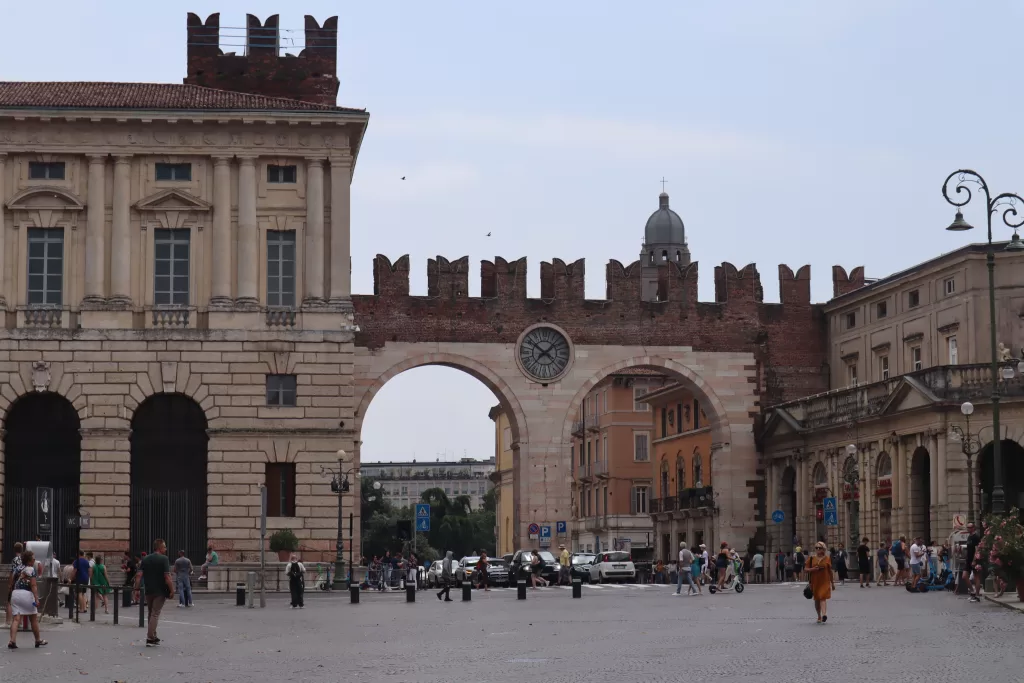(The items I list here are from my special list of the best things to do in Verona. But in all honesty this is only a partial list. For the sake of brevity I forced myself to restrict the list to just 12 items.)
Lovely Verona, set comfortably along the two banks of a section of the River Adige, is a pleasure to behold. The historic center is a peninsula resting snugly beside the flowing waters of the Adige. Verona is a vibrant city of 280,000 inhabitants and full of historic sites, good restaurants, good pastries, and good gelato. The streets are pleasant and the piazzas are wonderful.
Verona has an ambiance that reflects a durability spanning multiple centuries. You will find plenty of Roman walls, gates and Roman remains. Medieval and Renaissance Verona is there scattered throughout the historic center. And more modern Verona is also there, especially in Via Giuseppe Mazzini where throngs of tourists stop to admire luxury items in fancy store displays.
There is something for everybody here. If you have a car, there are at least 10 wineries within fifteen miles of the historic center. Wonderful architecture is everywhere, as well as beautiful churches, lots of history, and many pleasant neighborhoods and piazzas for self-guided walking tours. There are operas and concerts in a 2000 year old Roman arena. You can also find quiet places where you can sit by the River Adige and listen to the gurgling of the flowing water as you enjoy the warm sunshine under a balmy blue sky. And then there is food! Great glorious food! Restaurants are everywhere and food shops abound.
Verona is also very conveniently situated in northern Italy. It is located on a major rail line that extends from Milan in the west to Trieste in the east. (The trains are this line are sleek, fast, and very comfortable.) There are other rail lines extending north to the Dolomites and south to central Italy. Approximately 10-15 miles to the west of Verona lie the southern shores of Lake Garda, which can be reached by frequent bus service departing from Via Corso Porta Nova. There are regional and long-distance buses to many towns and cities. The train and bus stations are located a mile south of Piazza Bra and Verona’s local bus service is extensive.
A Little History:
Verona’s early history before the Roman occupation is not clear because the archaeological data is very meager. Various tribes such as the Euganei or the Cenomani or possibly the Etruscans may have inhabited the region. In any case, the Romans arrived and occupied the area in 300 BC. They built several roads that intersected Verona, making the town important for economic and defensive reasons.
A few centuries later, in 489 AD, Verona was conquered by the Germanic Ostrogoths as the Roman empire collapsed. This was followed by intermittent warfare between the Ostragoths and the Byzantine Empire. But in 569 it was conquered by the Lombards from the north. It remained under their control until 774 when it was conquered by Charlemagne and became part of the Kingdom of the Franks. Eventually the kingdom was split up among the descendants of Charlemagne, Verona going to a kingdom that stretched in a narrow strip from the North Sea down to Rome.
Gradually Verona and the other towns and cities in northern Italy became somewhat autonomous. By the early 12th century they had become truly independent republics. Meanwhile, Verona and the other northern Italian republics continued to prosper. But greed and lust for power resulted in frequent warfare as well as the building and breakup of various alliances between some of the towns and cities.
Then in 1797 Napoleon occupied northern Italy. Over the next few years northern Italy became a bargaining chip as it went back and forth from French rule to Austrian rule. But in the early to mid 19th century a movement to form an Italian nation arose and grew in the Italian peninsula. After much warfare, more and more of the Italian peninsula became part of a united Italy. In 1866 Verona and the Veneto region became one of the last pieces added.
Things to do in Verona:
1. Piazza Bra
To a large extent, Piazza Bra is the heart of Verona. This lovely Piazza consists of a pretty green park, a vast cobble-stoned area lined with many restaurants, a 2000 year old Roman arena, and the Verona city hall. This Piazza absolutely pulses with life. Tourists pass through or stop for an aperitif or meal at a restaurant or sit and relax on one of the convenient park benches. Locals cluster in groups to chat with acquaintances while on their evening passeggiata. And children frolic around the fountain and the flowers, watched by loving, patient parents. This is certainly one of the most enjoyable piazzas I have ever encountered.
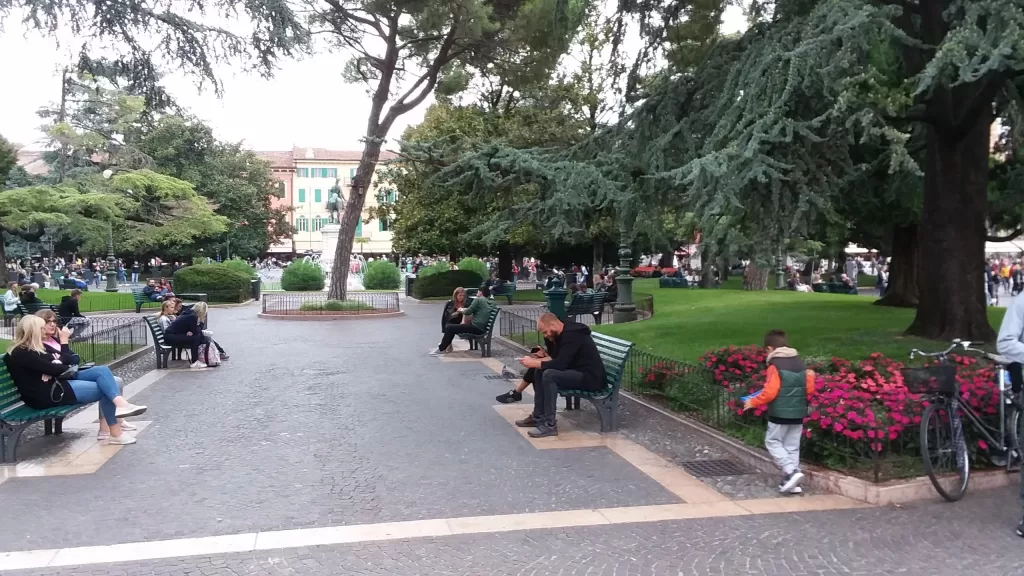
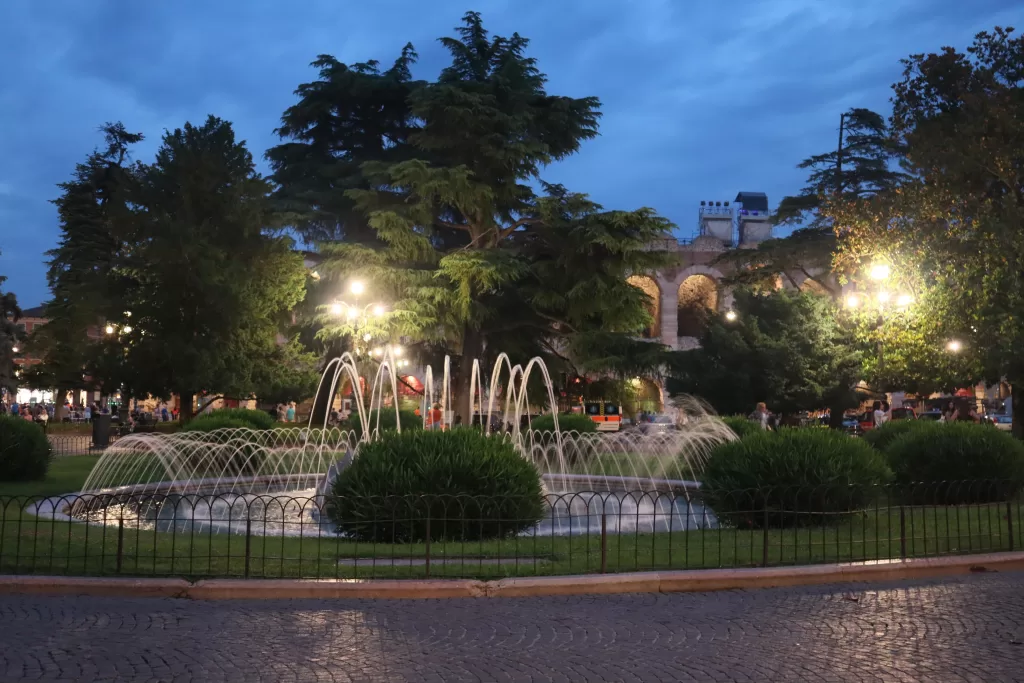
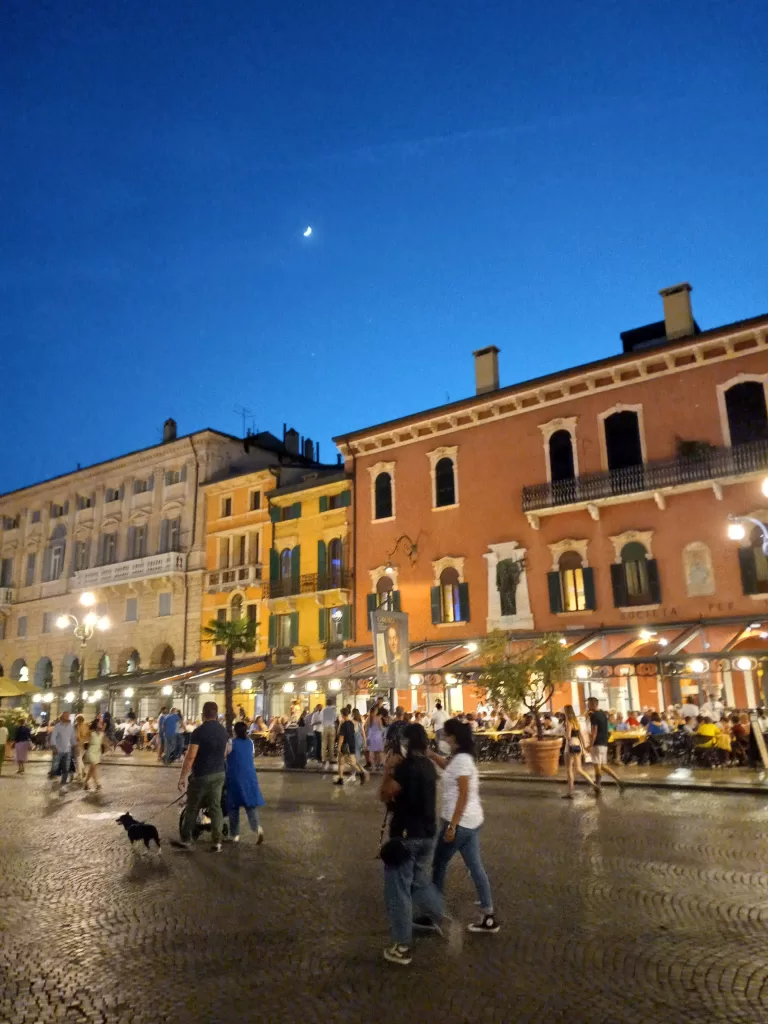
2. Roman Arena
The Roman arena in Verona, completed in 30 AD, is approximately 40-50 years older than the coliseum in Rome. In ancient times it could host more than 30,000 spectators who would come to watch the gladiatorial fights. (The gladiator school was located off of Piazza Bra where the Verona town hall, the Palazzo Barbieri, now stands.) Stones from the Valpolicella valley which is located 10-15 miles north of Verona, were used for its construction. These stones are referred to as “Rosso Verona” because of their reddish color.
Opera was occasionally performed in the arena during the Renaissance, although not customarily. Eventually, during the 1850s, opera began to be performed here more frequently. In 1913 the arena’s excellent acoustics convinced enough people to make the arena a true opera venue. In modern times four to six opera productions are performed here during opera season. The arena also hosts several concerts of international rock and pop bands each year.
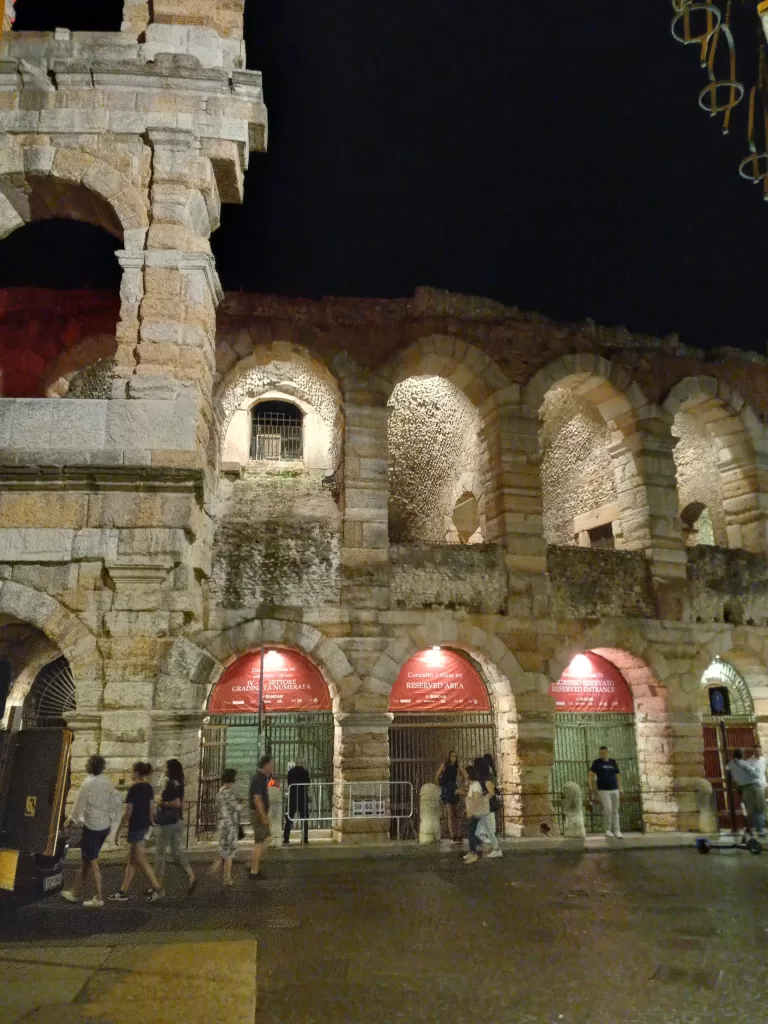
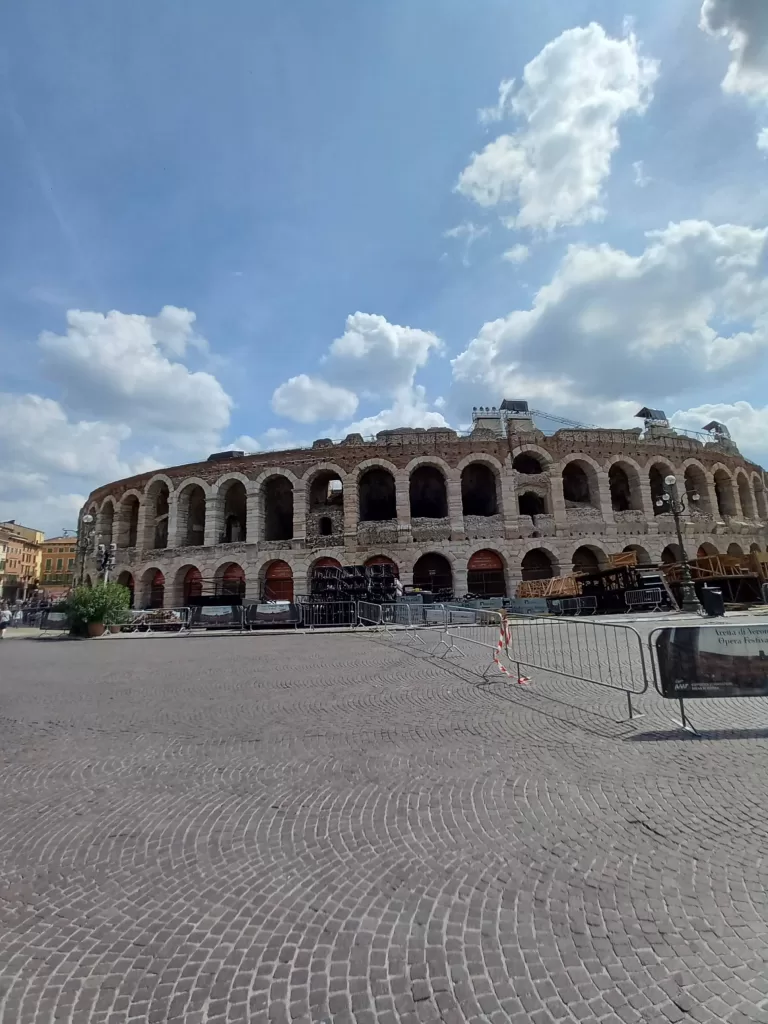
3. Piazza delle Erbe
This pleasant piazza, located almost in the center of the peninsula, was the town’s forum during the time of the Roman Empire. Today it is lined on one side with numerous restaurants and across the street with shops and more restaurants. The upper stories of these buildings are decorated with beautiful frescoes. At the far end is the crenellated Casa dei Mercanti which now houses a bank. In the center of the piazza is a fountain built in 1368.
In the Middle Ages the piazza was used as an outdoor market for spices, fruits, and vegetables. Today only two or three stalls remain that still sell fruit and vegetables. The other stalls sell a variety of souvenirs.
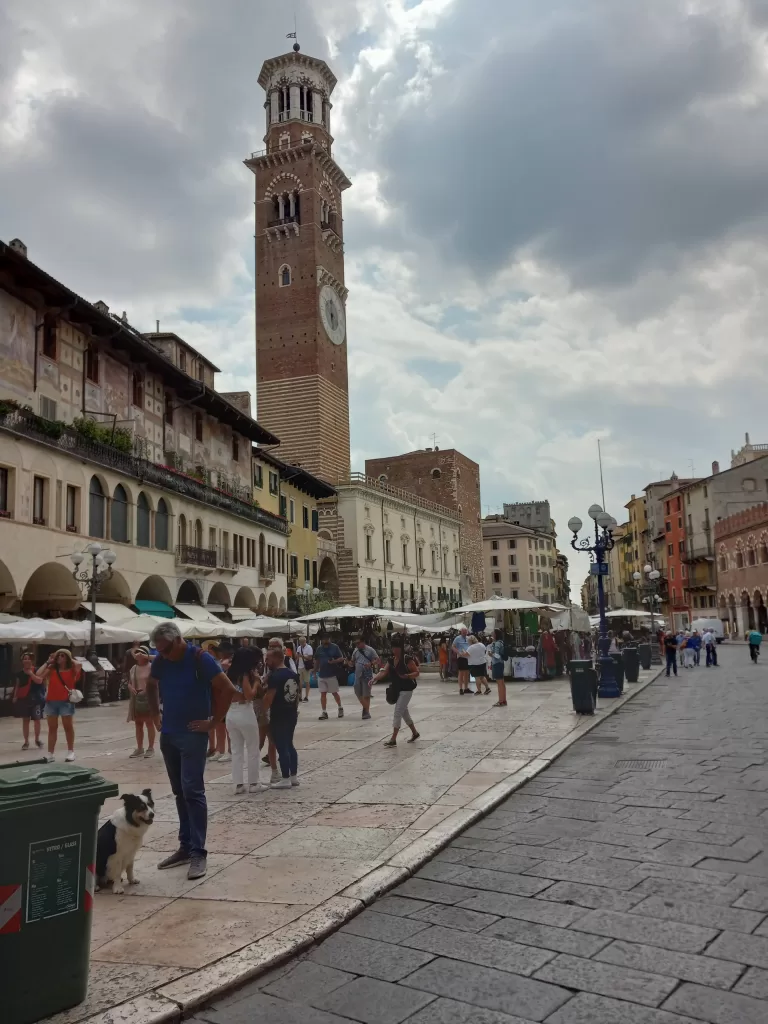
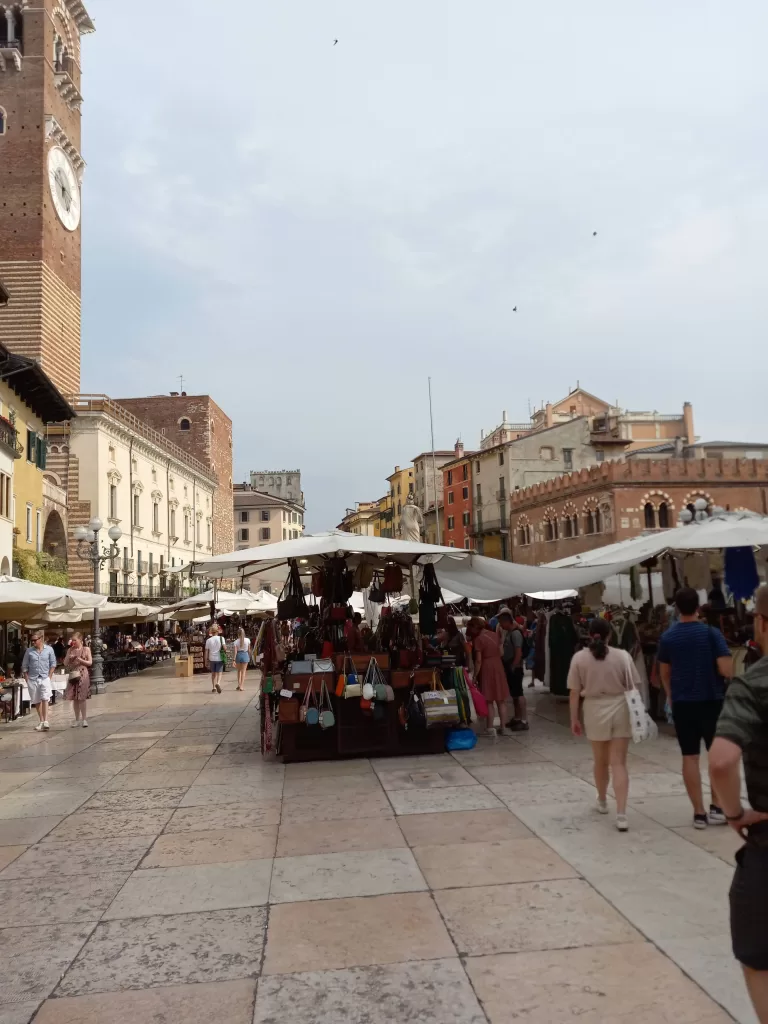
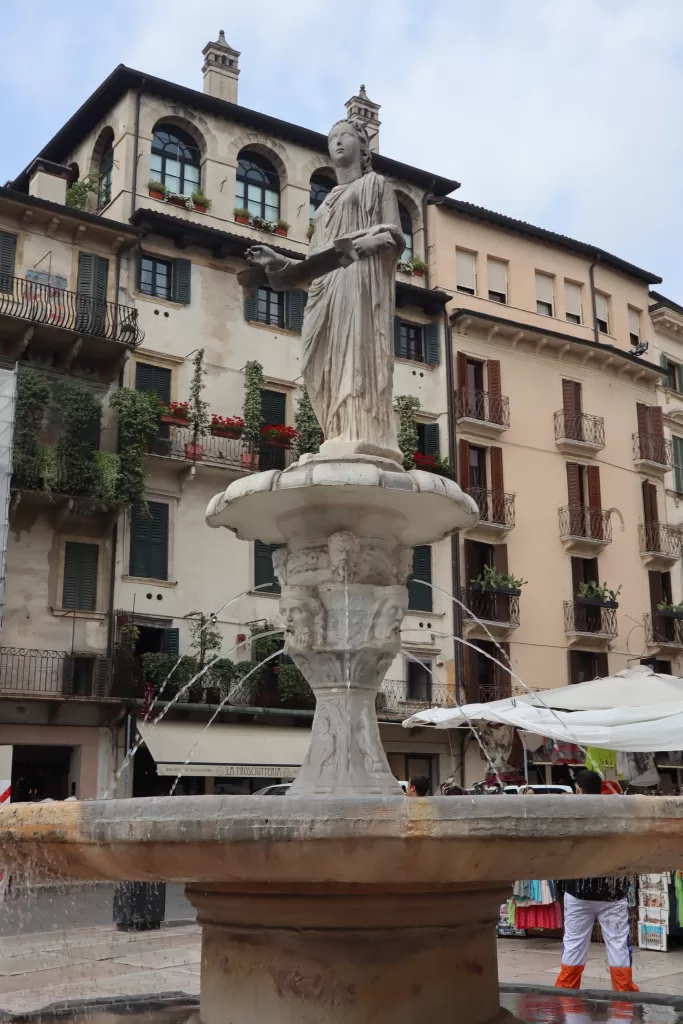
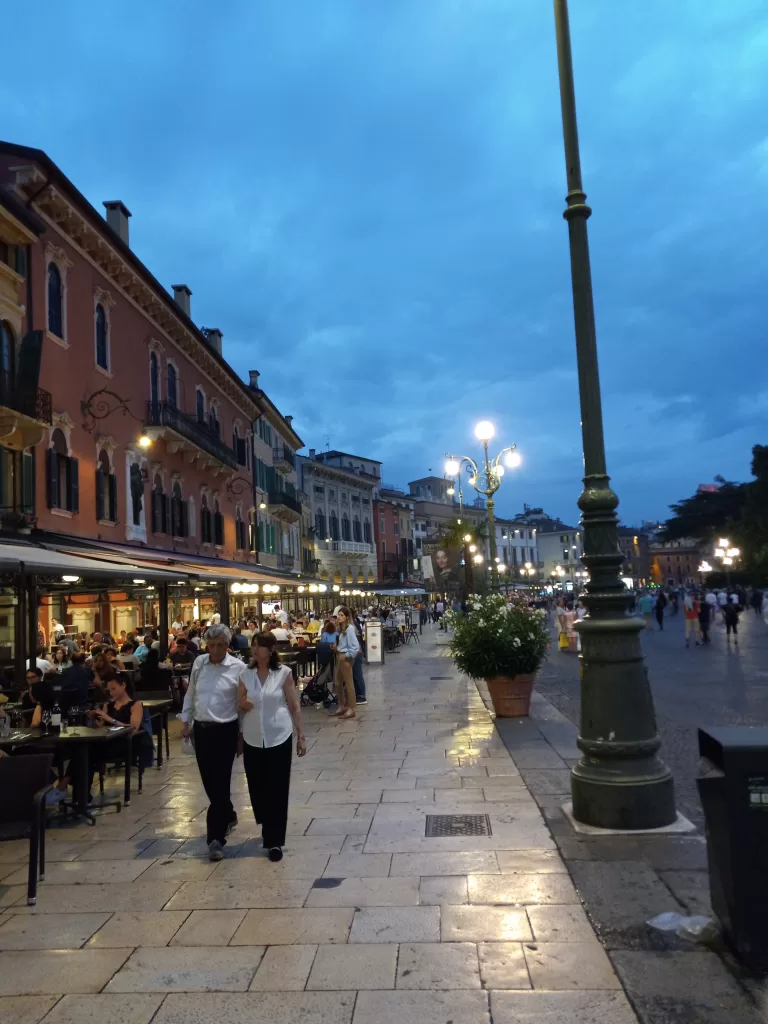
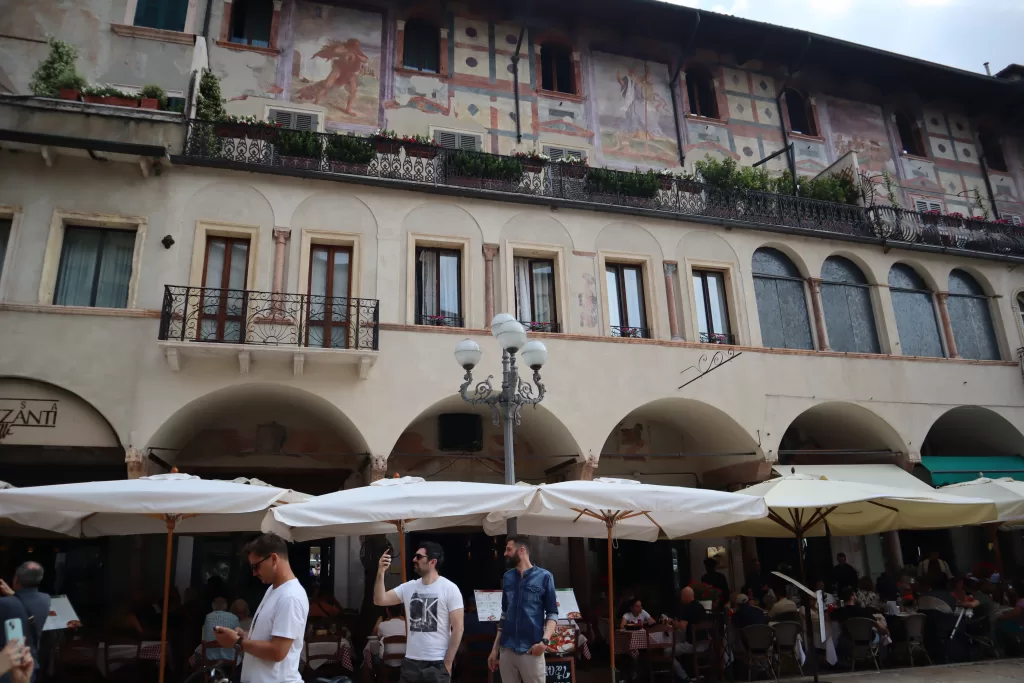
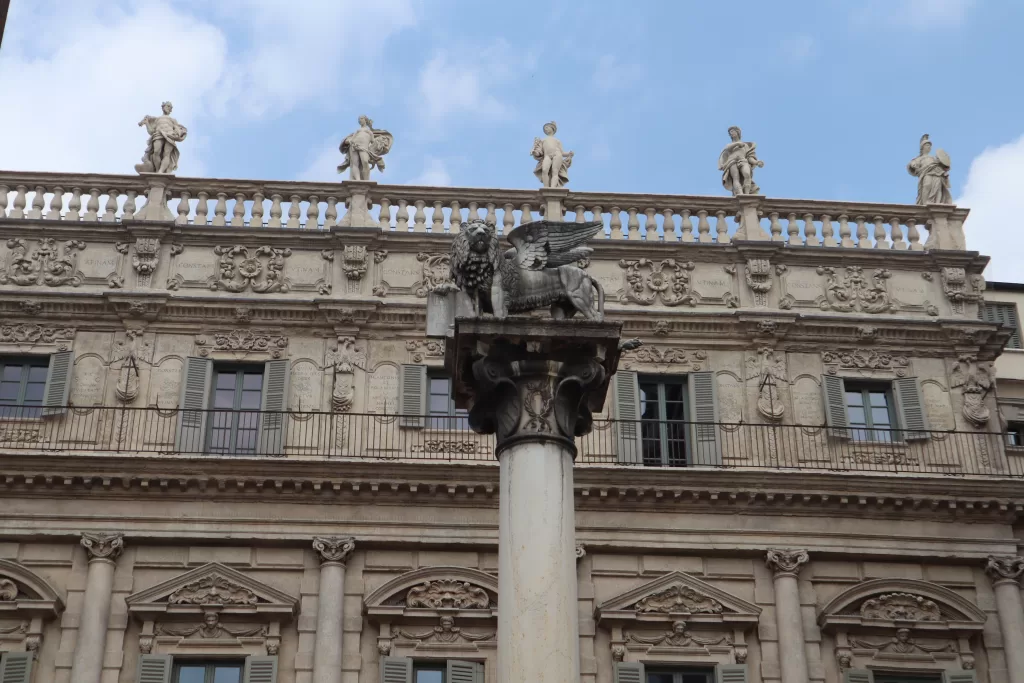
4. Piazza dei Signori (also known as Piazza Dante)
This pretty piazza is surrounded by majestic architecture that includes a palace and the former public institutions of Verona. Looking around you will see that each building is connected to its neighbor by arches. Also, the foundations of some buildings were erected on top of what used to be a series of medieval tower-houses.
The Loggia del Consiglio is the oldest pure Renaissance style building in Veneto region. To its right is the Palazzo della Ragione which includes a tower (Torre dei Lamberti). This building dates back to the 12th century and was used as a city court during the years when Venice ruled Verona.
The building topped with battlements is the Scala Family Palace. The Scala family ruled Verona from the end of 1200s until Verona came under the rule of Venice near the end of the 1300s. The Venetians used the building as the official residence of the Venetian governor.
Since the piazza includes a statue of Dante Alighieri, the locals refer to this piazza as Piazza Dante.
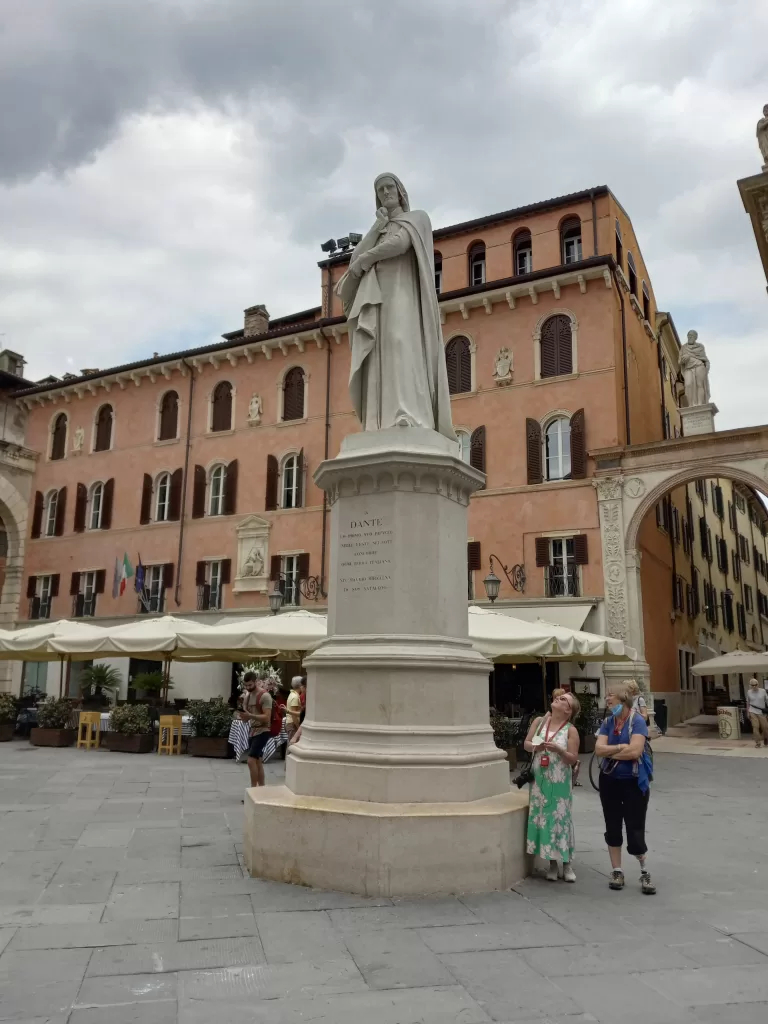
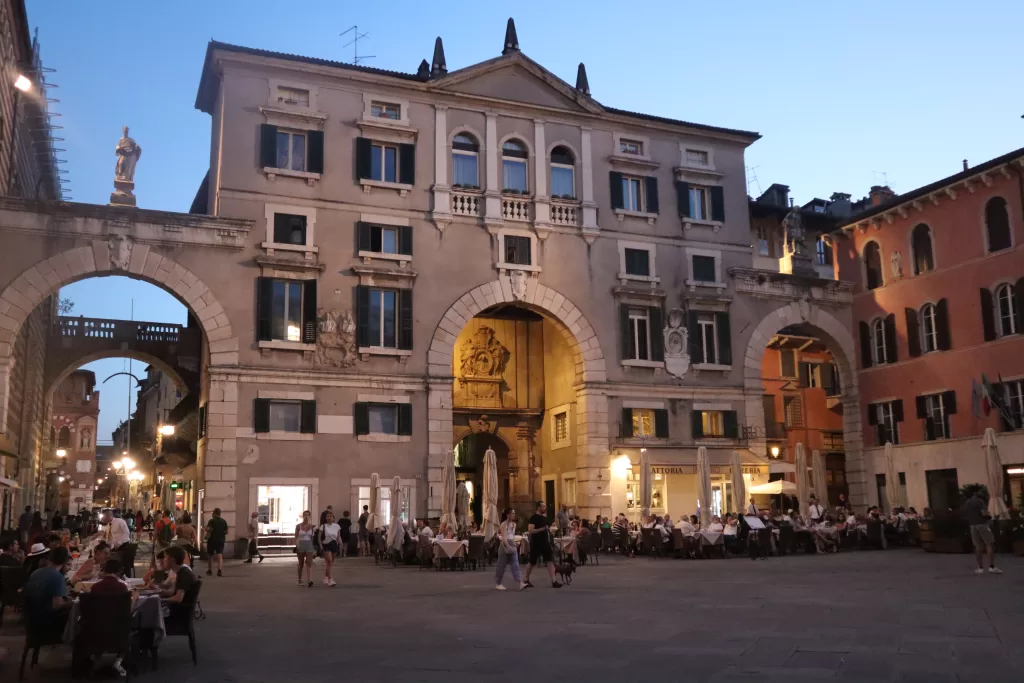
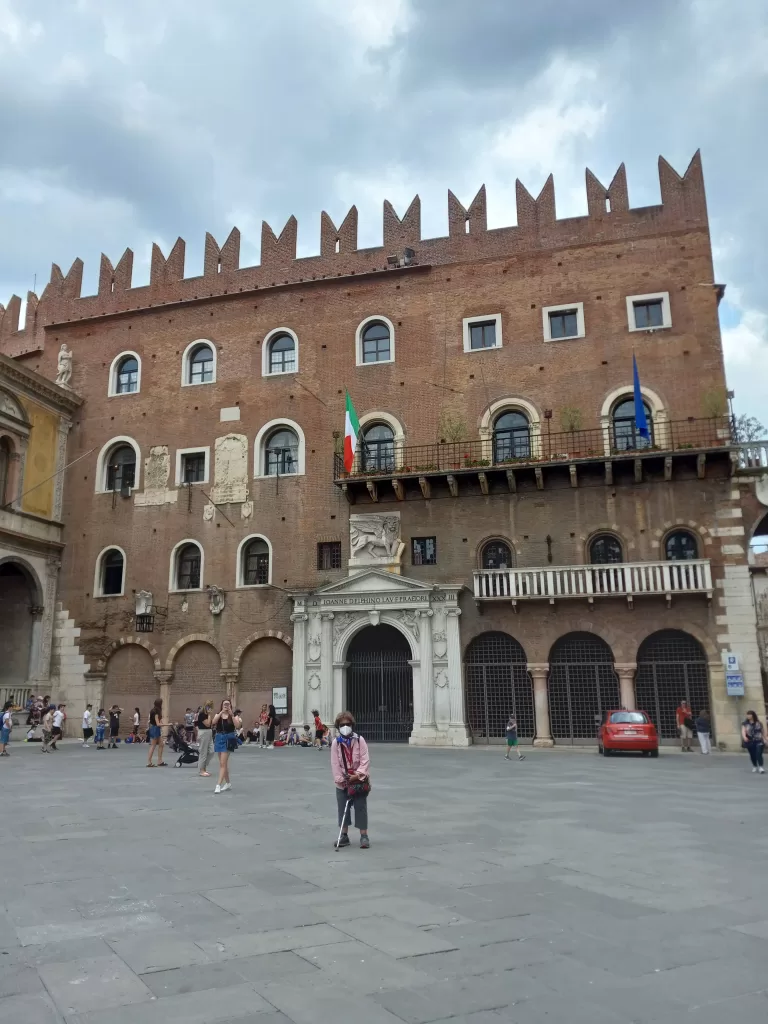
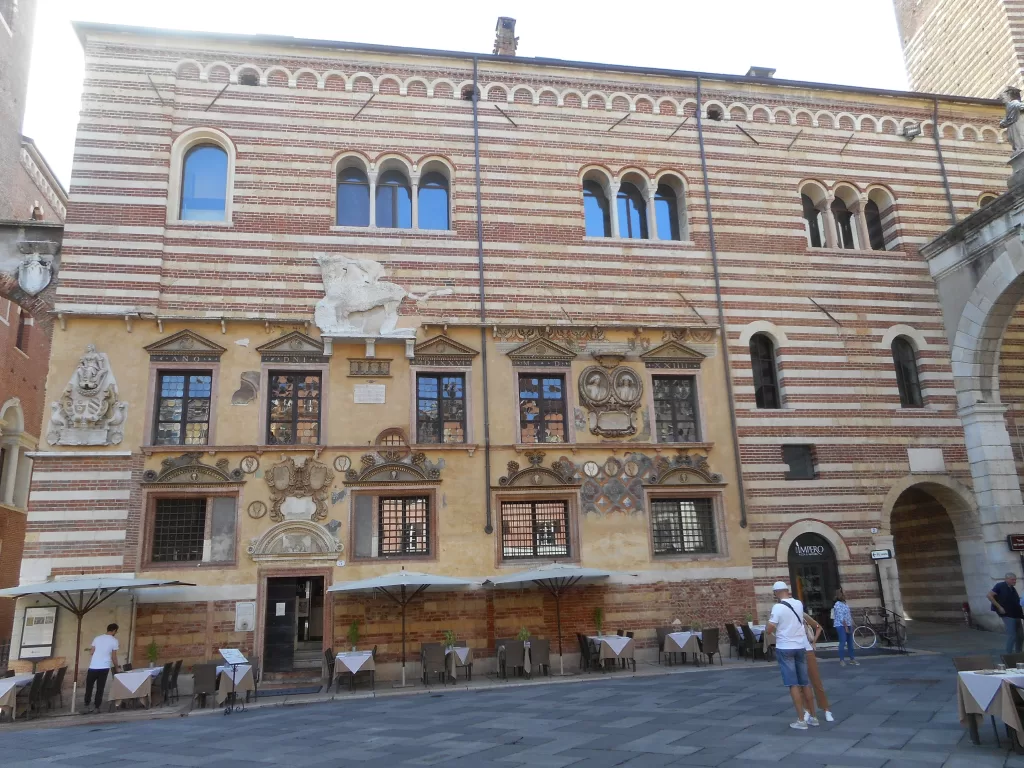
5. Ponte Pietra and views from River Adige
The picturesque Ponte Pietra spans the River Adige in the far northeastern part of the penninsula. It is a Roman arch bridge completed in 100 BC and one of the major Roman roads, the Via Postumius, had passed over it. Part of the bridge was destroyed by retreating German troops in World War II. In 1957 the damaged section was rebuilt using the original materials.
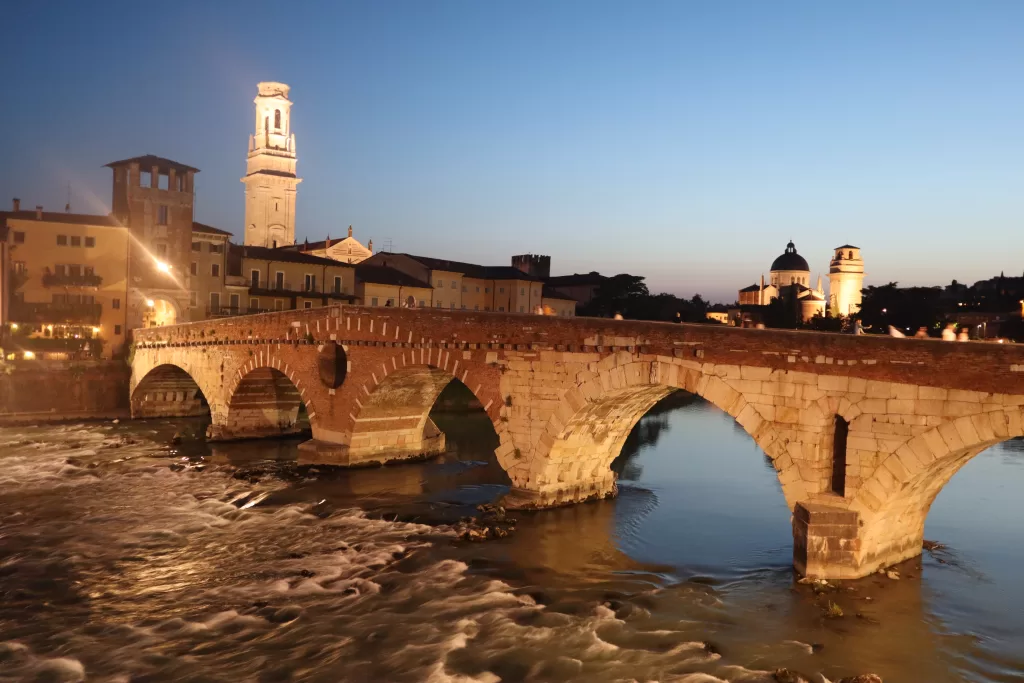
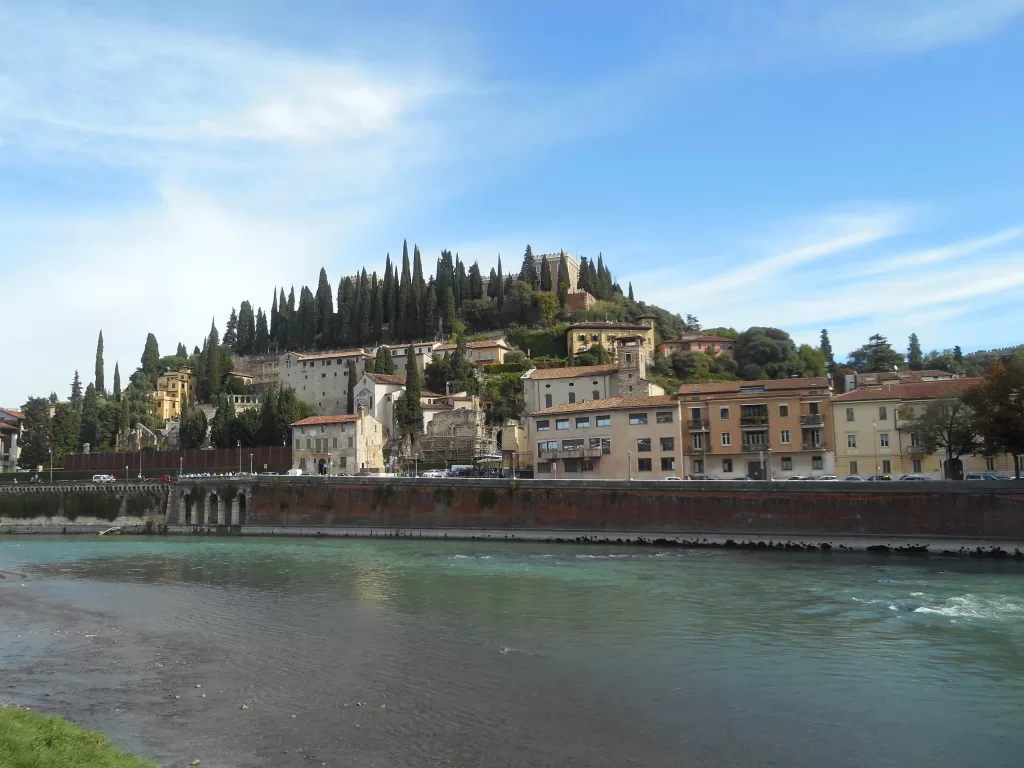
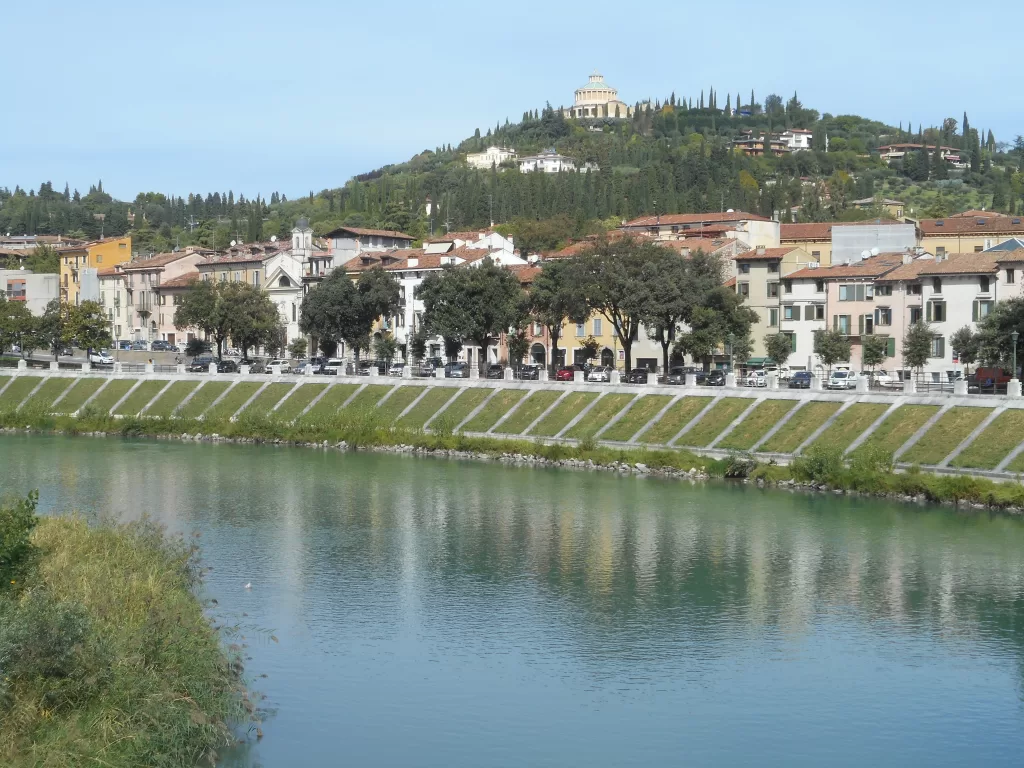
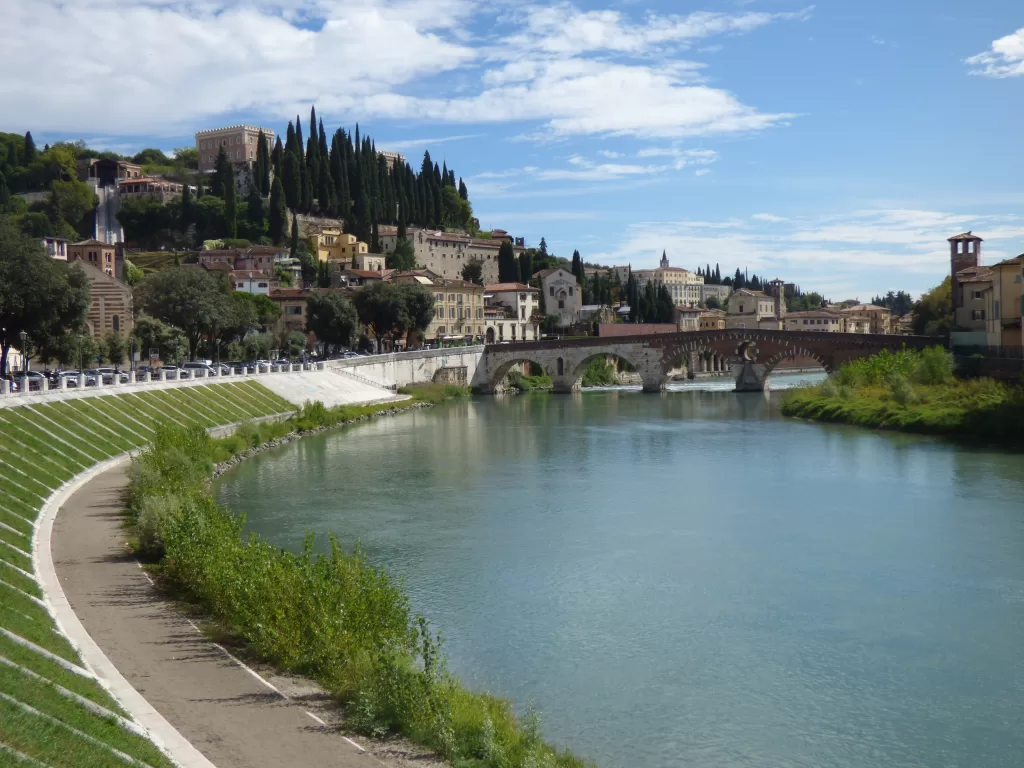
6. Giardino and Palazzo Giusti
The pretty Renaissance garden and the palazzo of the Giusti family is well worth a visit. It is located on a slight hill east of the River Adige, approximately a 10 minute walk from the Ponte Pietra. The garden has sculpted shrubs and hedges, fountains, and statues. The palazzo dates from the late 16th century and is still being refurbished. Several rooms have been completed. Bombs damaged part of the building during WWII when the building was being used by the occupying Germans. The building was partly restored in 1954. The property is still owned by the Giusti family and is now a museum.
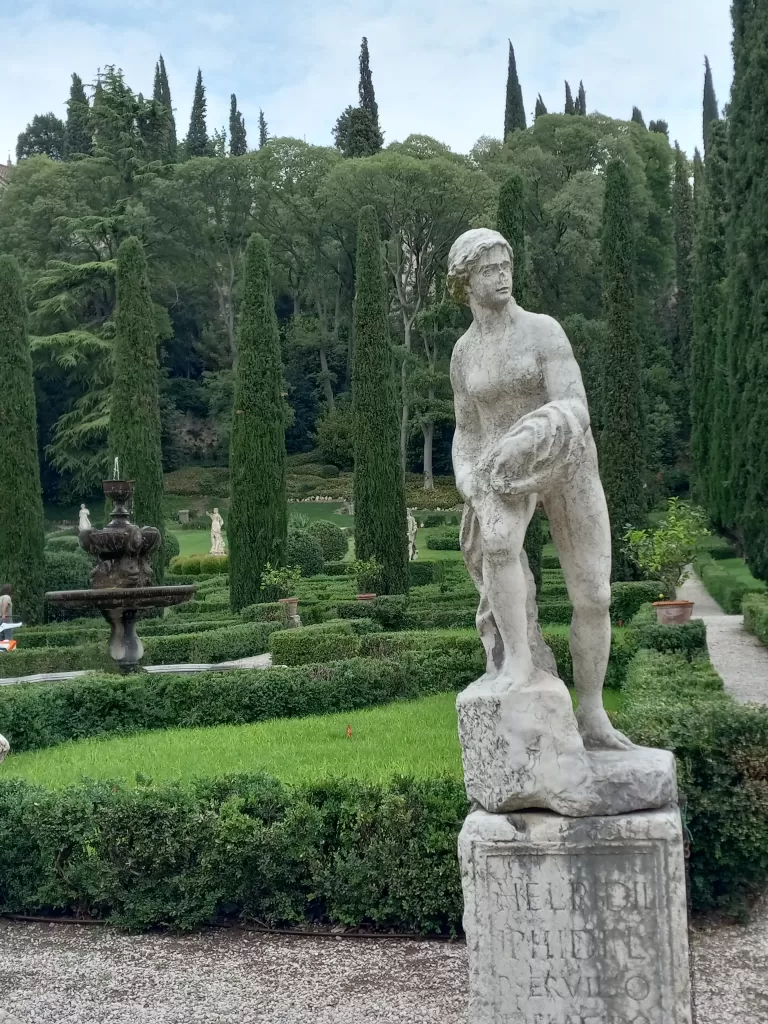
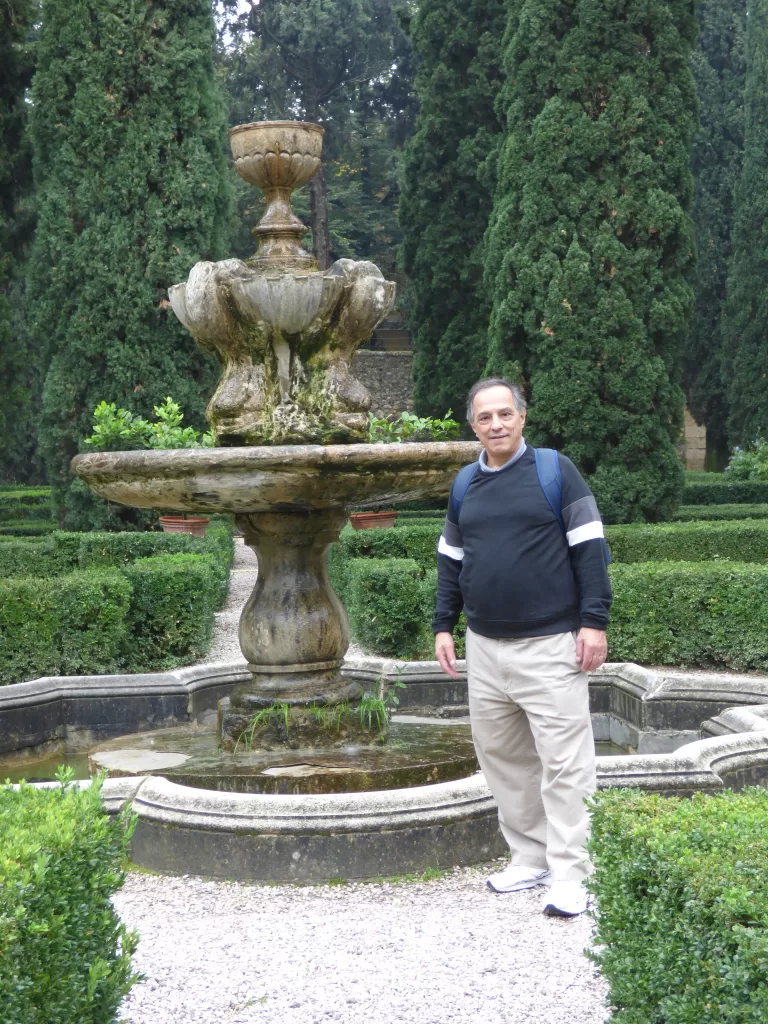
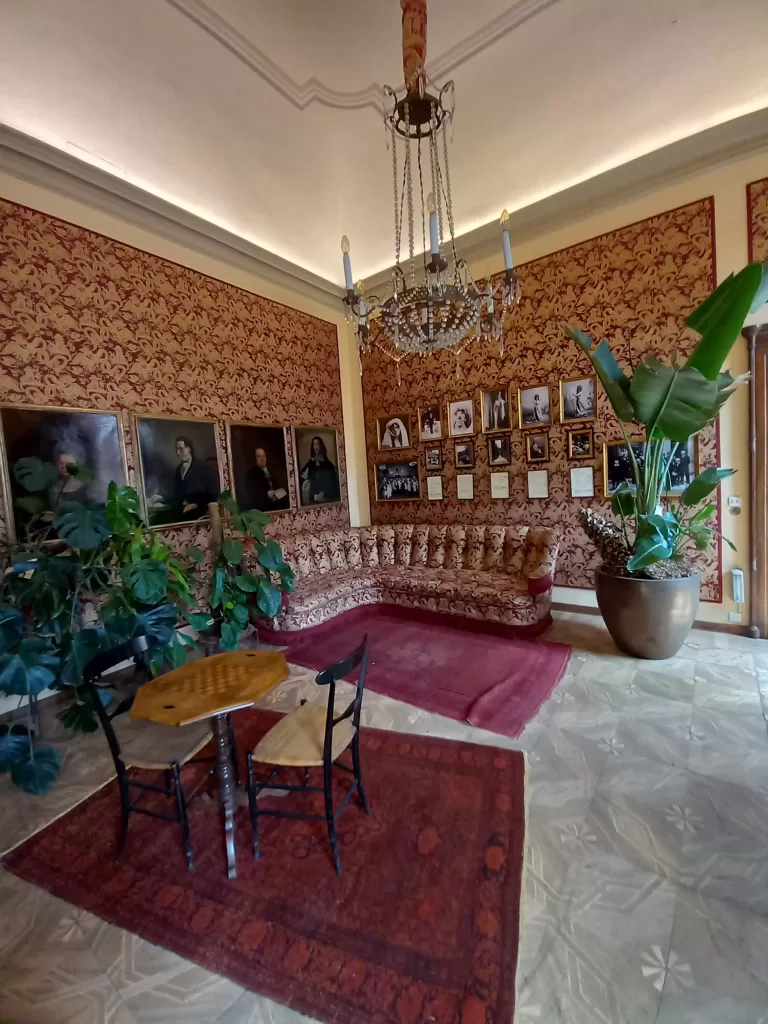
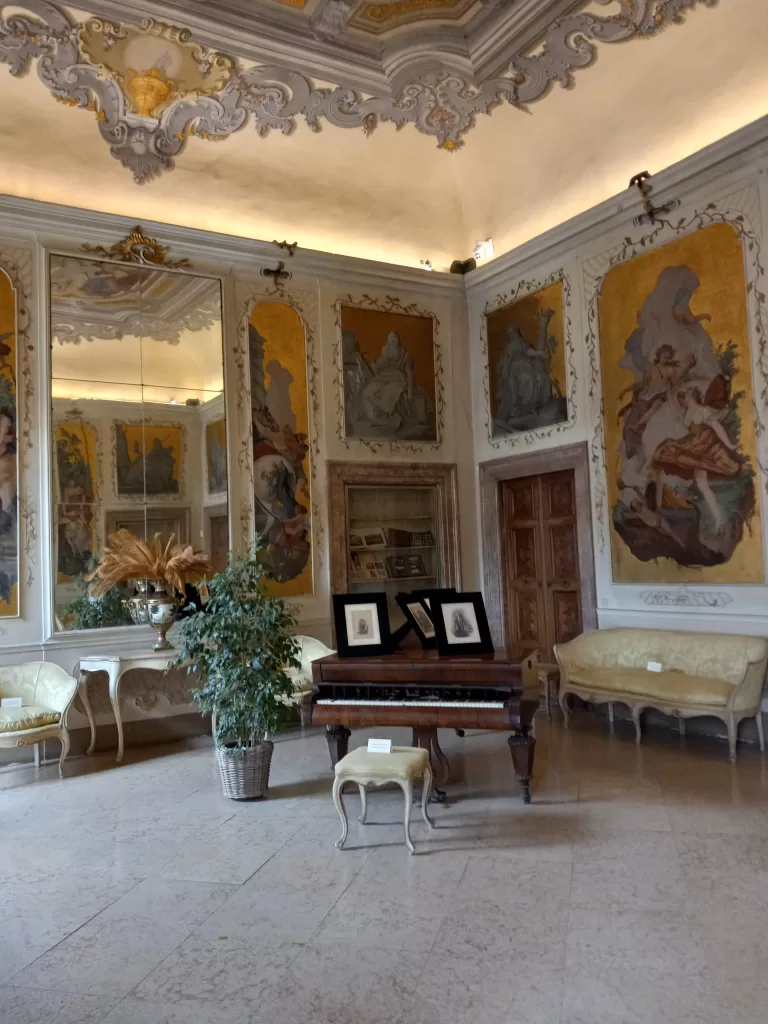
7. Roman theater and the Archaeological Museum
Up a moderately steep hill east of the River Adige lies the Roman theater and the Archaeological Museum. (The Roman theater resembles ancient Greek theaters rather than Verona’s coliseum-like Roman Arena.) The Archaeological Museum is housed in the former Renaissance convent of San Gerolamo. The museum includes remains of sculptures and a wonderful model of Verona’s Roman Arena. From the museum and the Roman theater you can get fascinating views of the River Adige and the historical center of Verona.
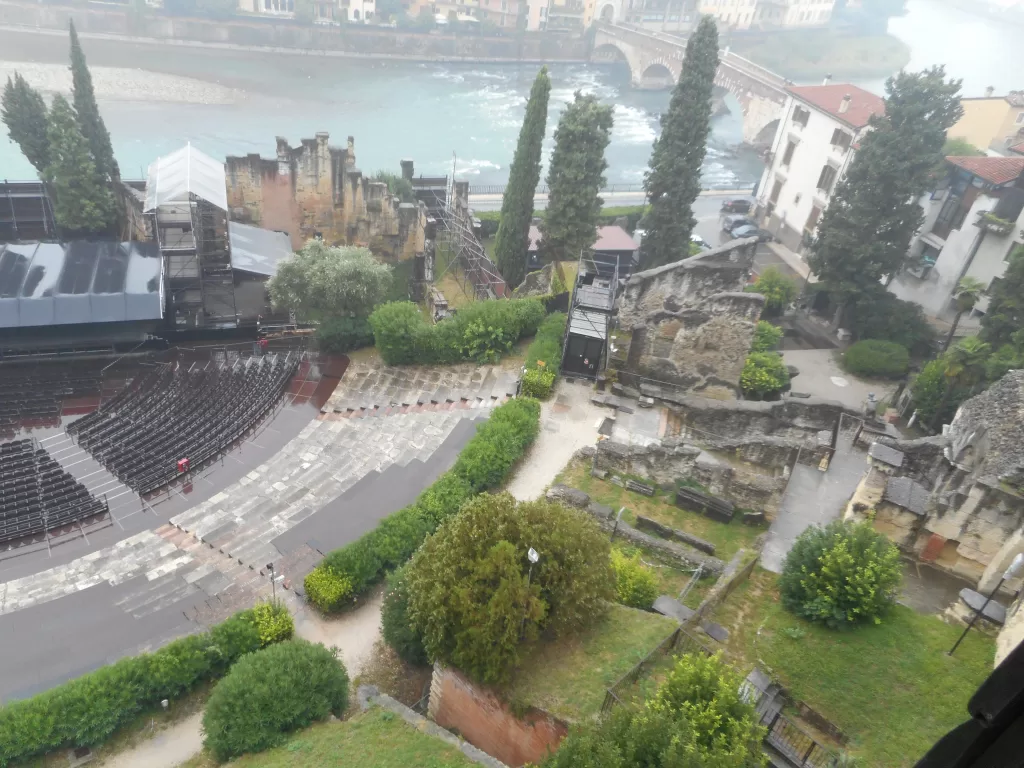
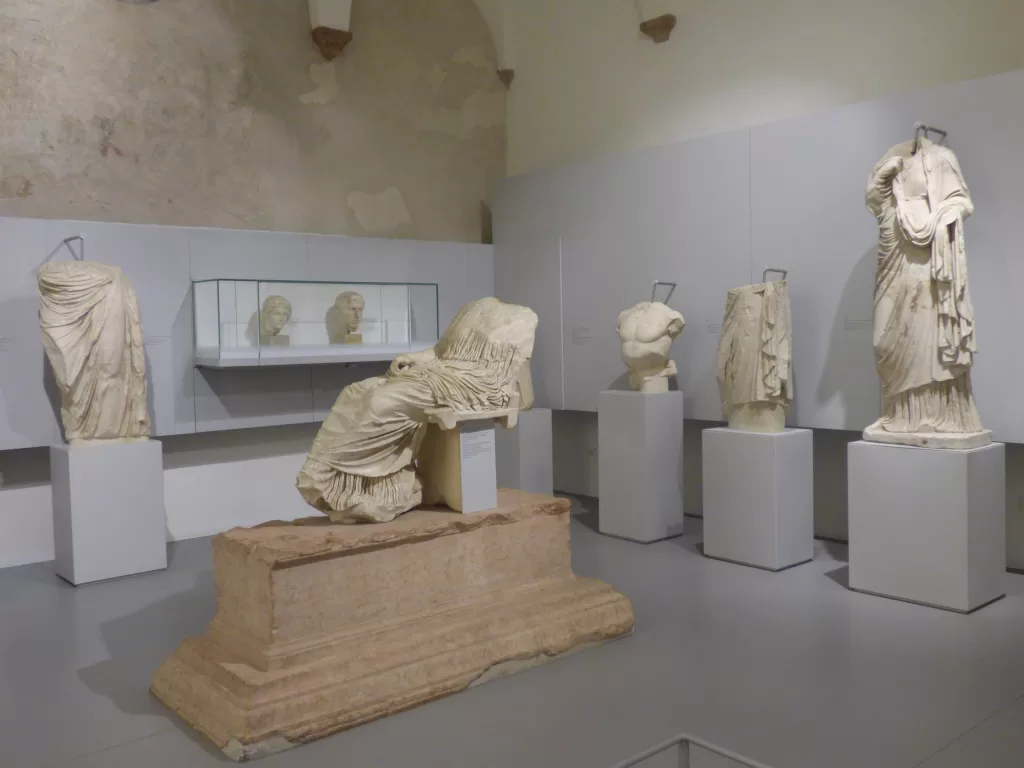
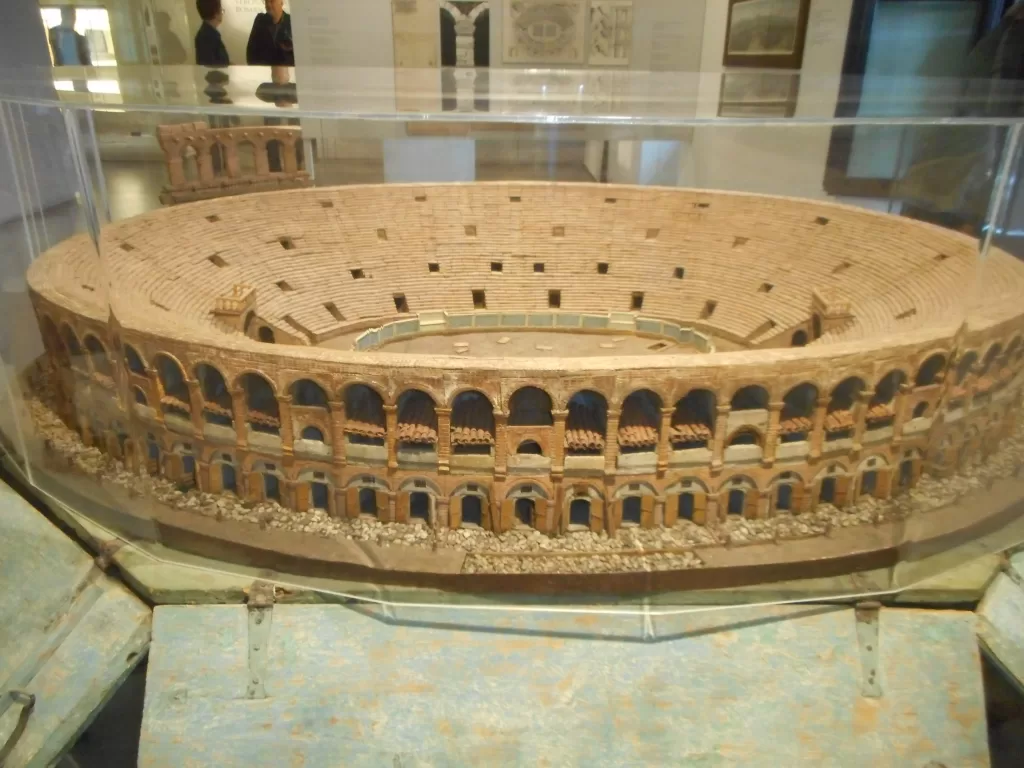
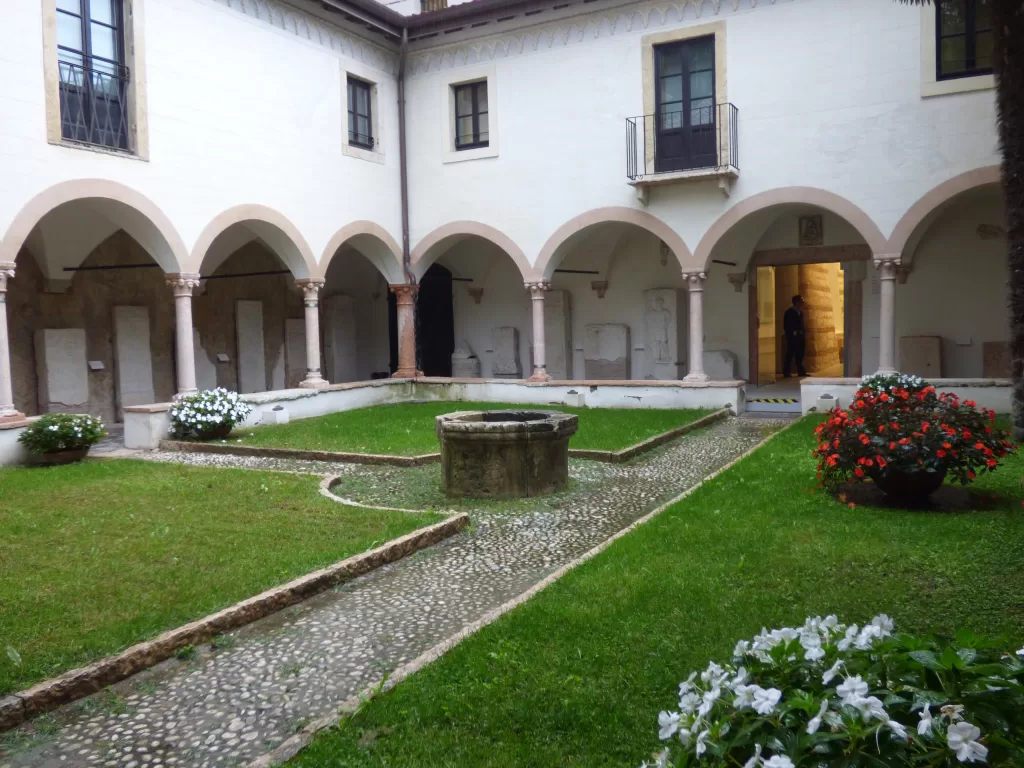
8. Ponte Scaligero and Castelvecchio
The Scaligeri family had this castle and the Ponte Scaligero constructed between 1354 and 1376. It was their residence as well as a fortress providing protection against Venice and from their powerful neighbors, the Gonzaga and Sforza families. Eventually the power and influence of the Scaligeri family faded and the surviving members left Italy. The Castelvecchio contains many statues and paintings as well as a small armory collection.
The Ponte Scaligero was intended to allow the family to safely escape in the event of a rebellion. In 1945 the retreating German army destroyed the bridge. Fortunately this wonderful structure was rebuilt in 1949.
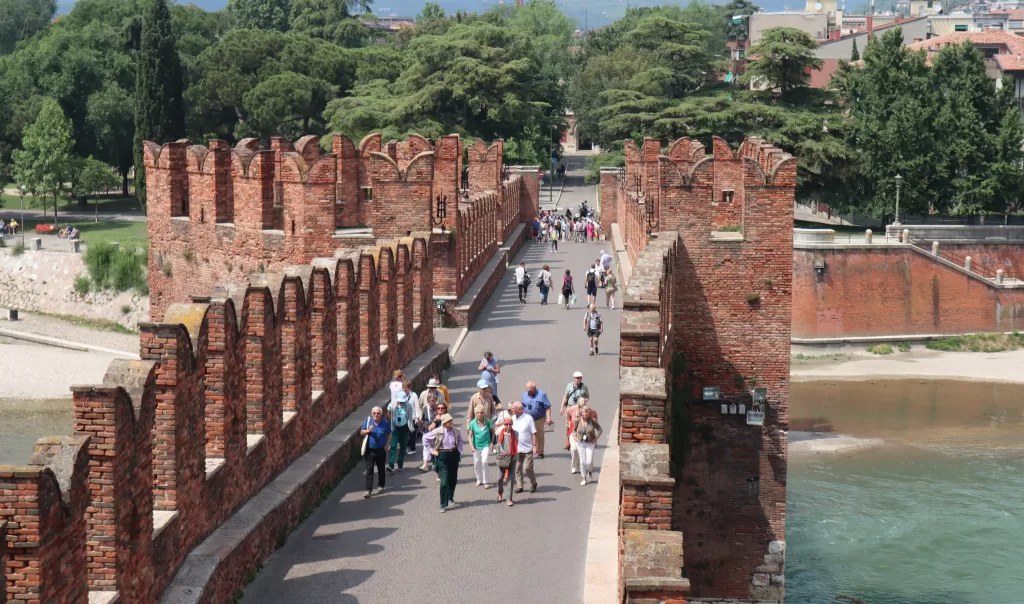
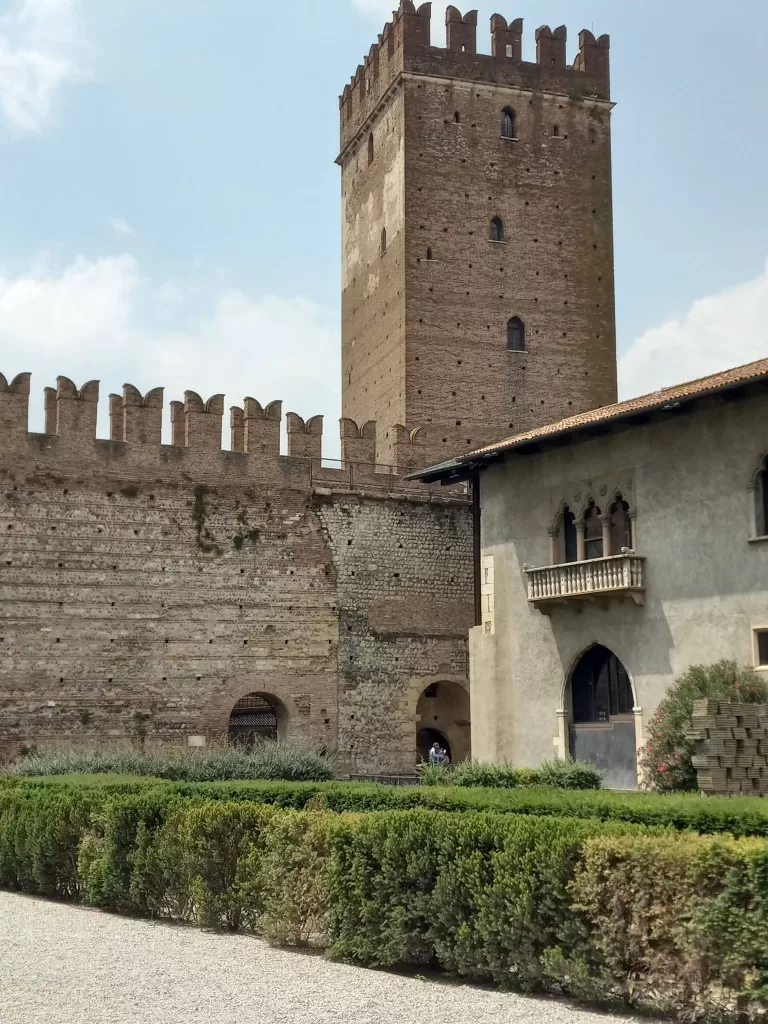
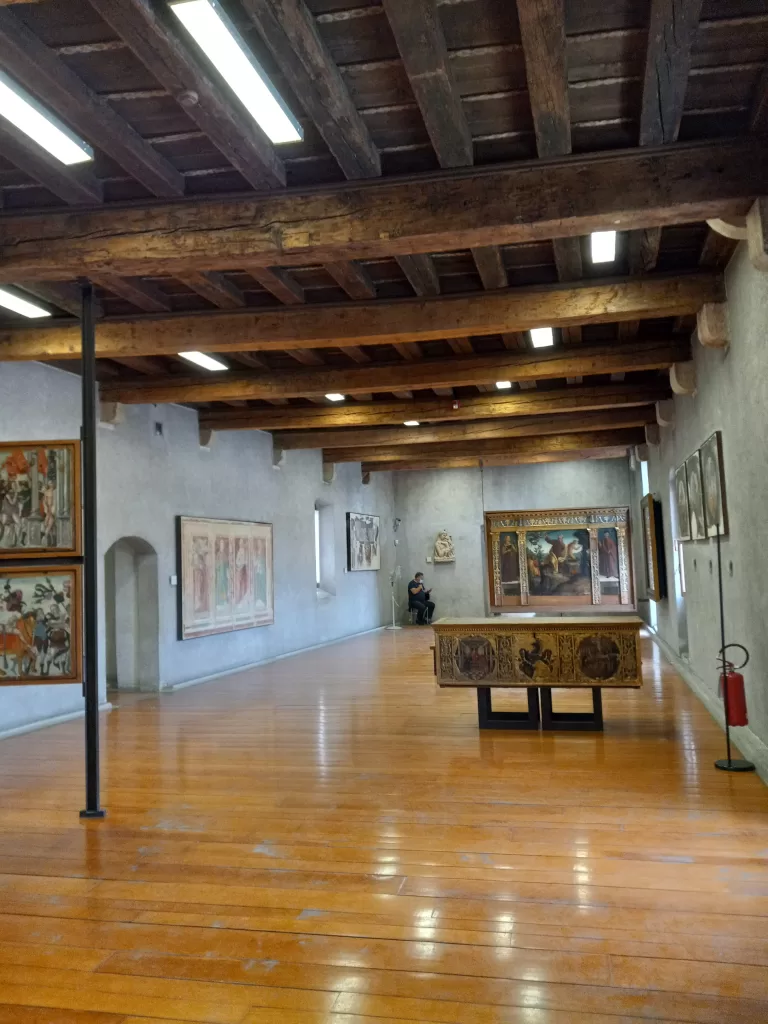
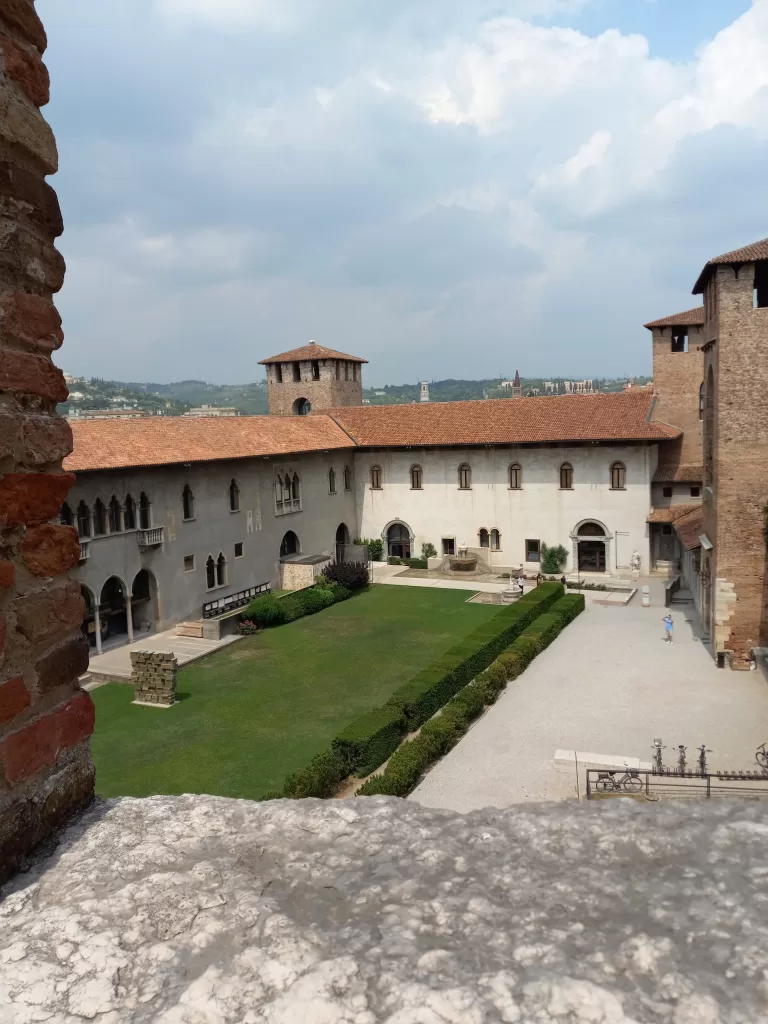
9. Views of Verona from Piazzale Castel San Pietro
Castel San Pietro was built in 1805 by the Austrian army after they defeated the French occupiers of the region. At that time the castle consisted of an Austrian army base and barracks. By 1866 when Verona became part of the united Italy the Austrians had summarily departed. Castel San Pietro fell into disuse and in 1932 it became the property of the Municipality of Verona. Unfortunately the building is closed to the public because its interior is unsafe due to the damage caused by many years of neglect. However, visitors can walk along the piazzale outside the building or sit on benches that overlook excellent views of Verona and its countryside.
Piazzale Castel San Pietro sits on a hill east of the River Adige. The site can be reached by walking up a steep path that starts across the street from Ponte Pietra. If you prefer you can instead ride an inexpensive tram up to the summit. The tiny tram station can be found just a few feet to the right of the intersection of Via Fontanelle S. Stefano and Lungadige S. Giorgio.
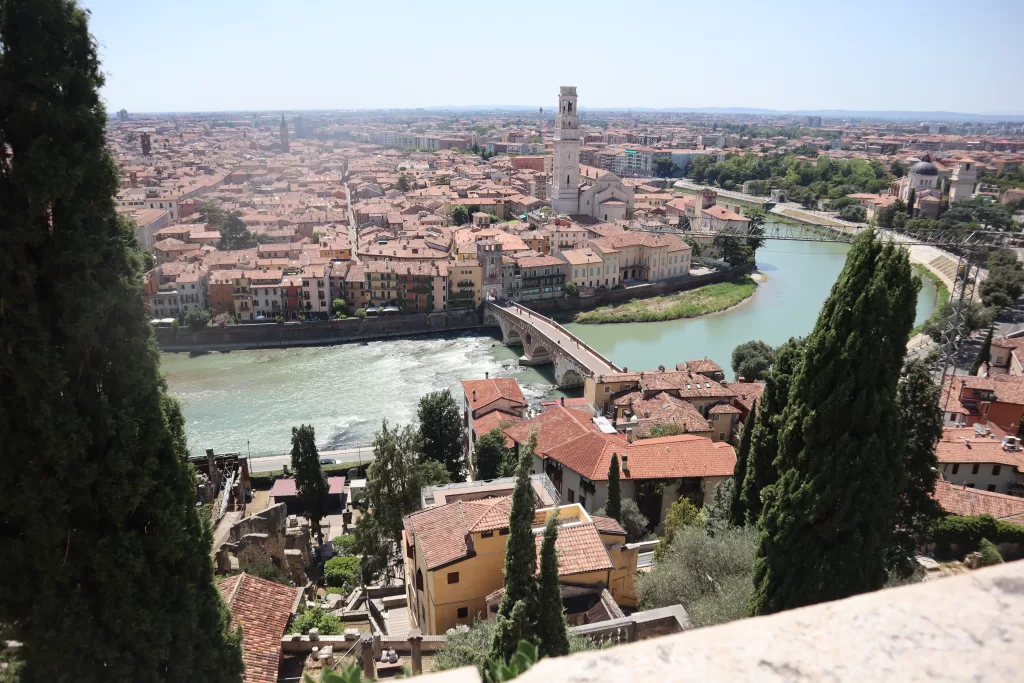
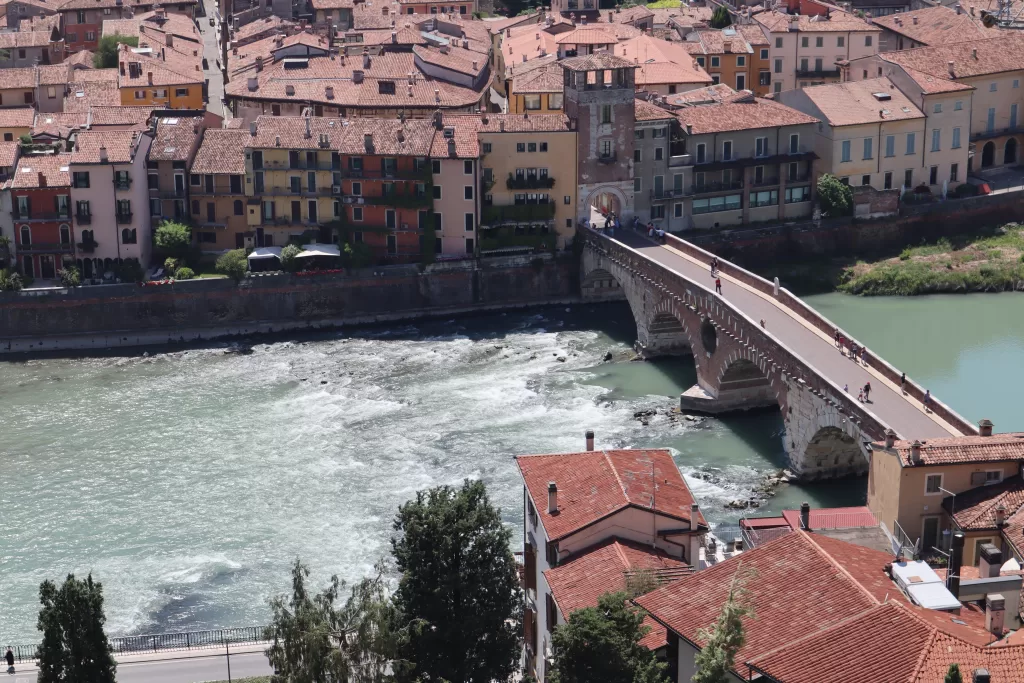
10. Basilica of San Zeno Maggiore
The Basilica of San Zeno is an excellent example of romanesque architecture. It was constructed between 967 and 1398 AD. Romanesque architecture dates from the mid-11th century to at least the mid-12th century. It is a fusion of Roman, Carolingian, Byzantine, and local Germanic styles and these churches have a solid, massive, and impressive appearance.
(Note: Tradition holds that its crypt was the place of the marriage of Shakespeare’s Romeo and Juliet.)
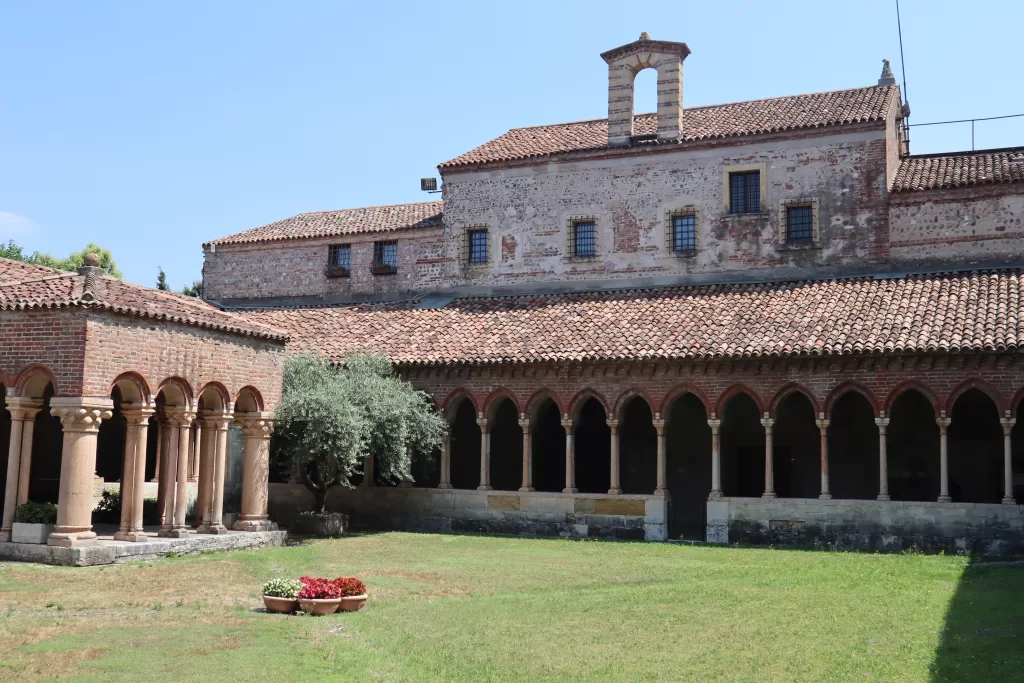
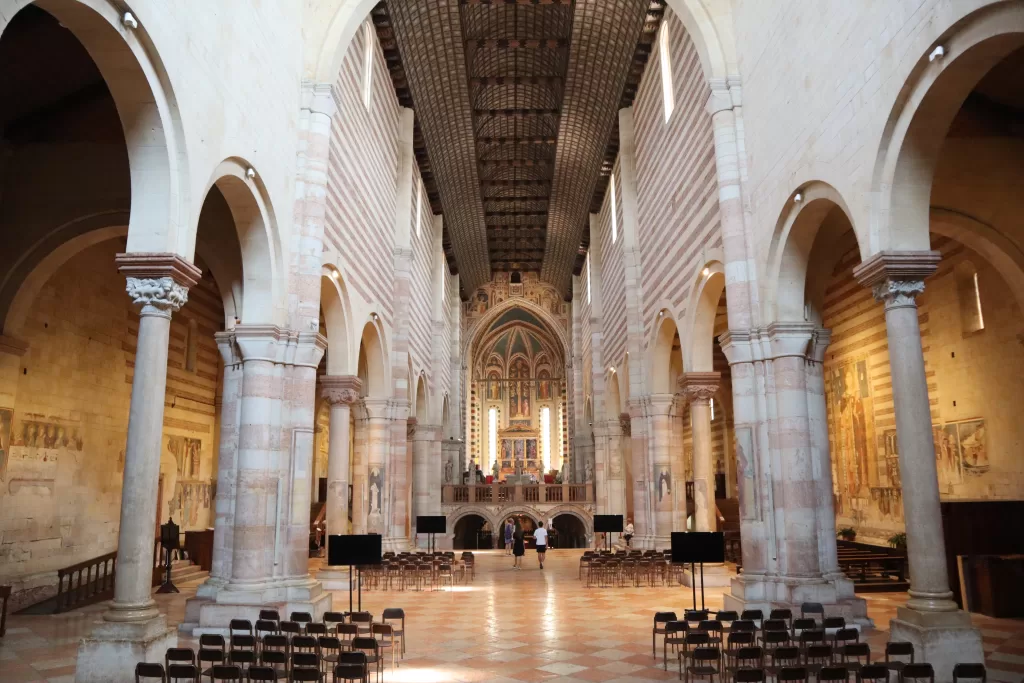
11. Parco delle Mura – a walk along Verona’s outer walls
The Parco delle Mura presents one of the best preserved fortification works in Europe. It also provides an ecological corridor important for maintaining biodiversity. The park includes a well marked path which follows Verona’s outer walls for approximately 5.6 miles (9 km). There used to be a moat along side the walls but it is now dry. The walls were built in the 12th century and extended in the 14th century. Several times between the 14th and 19th centuries the walls were partly damaged by invading armies but later reconstructed. Today the Parco delle Mura also hosts a small display of large wood sculptures.
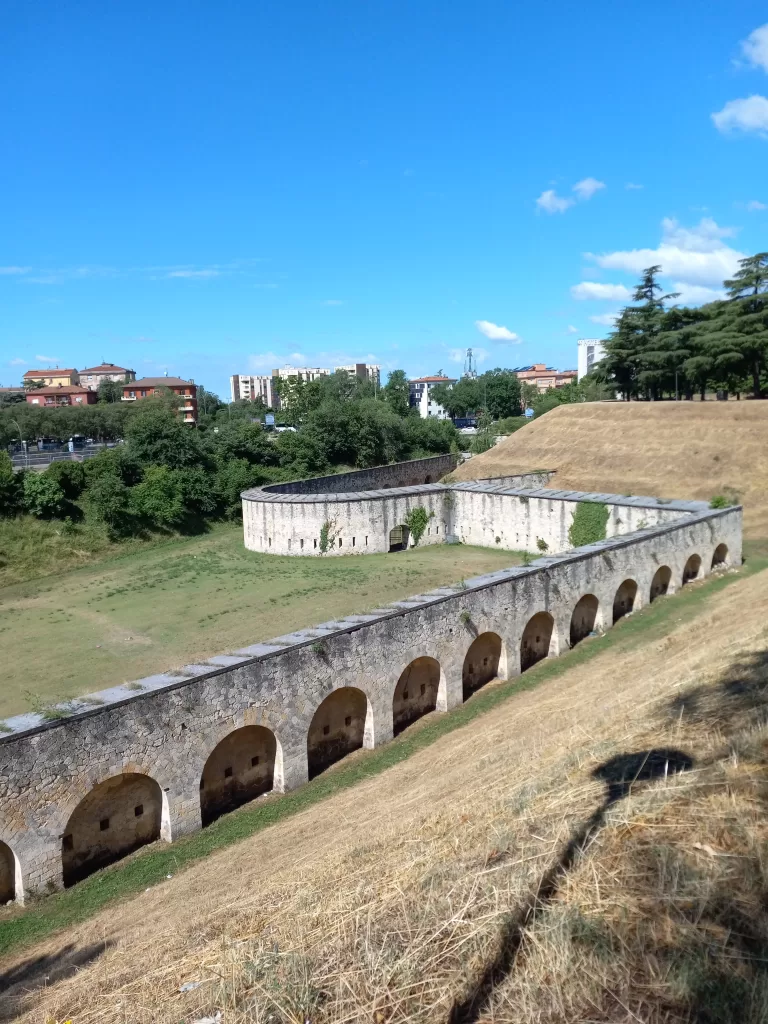
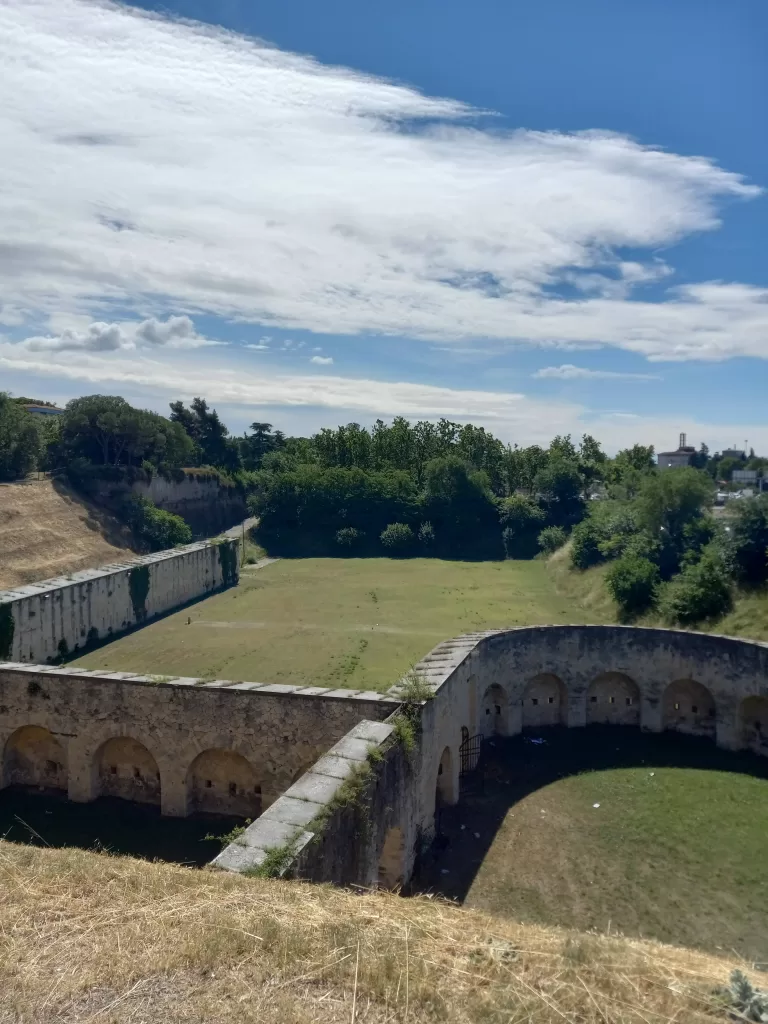
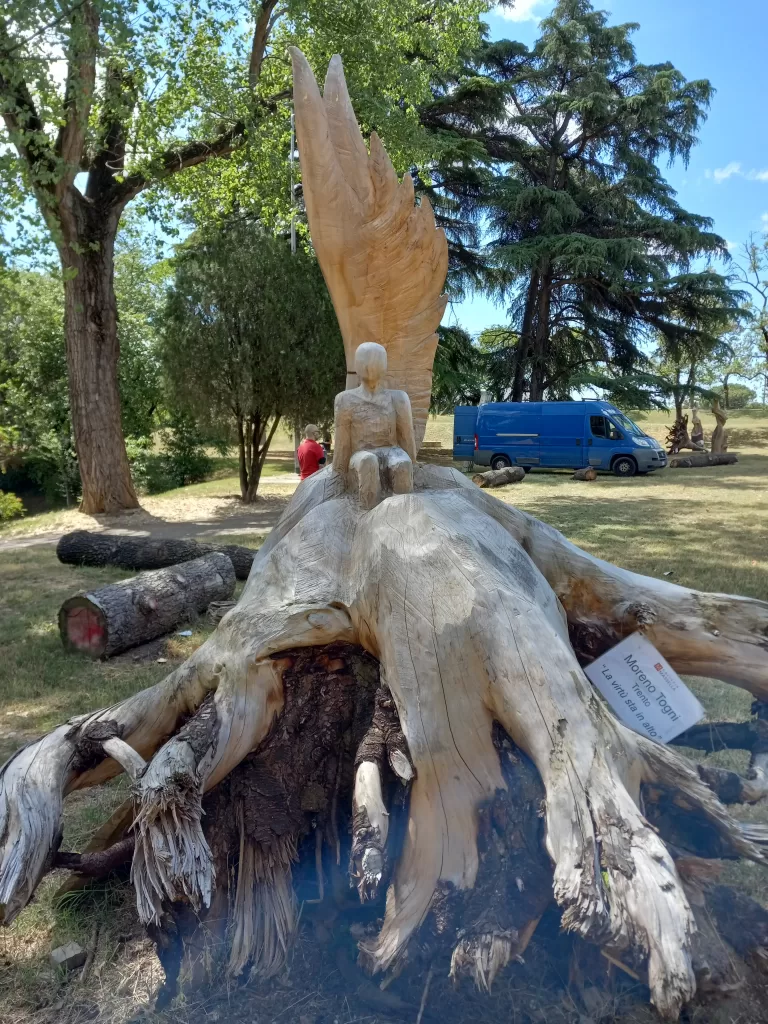
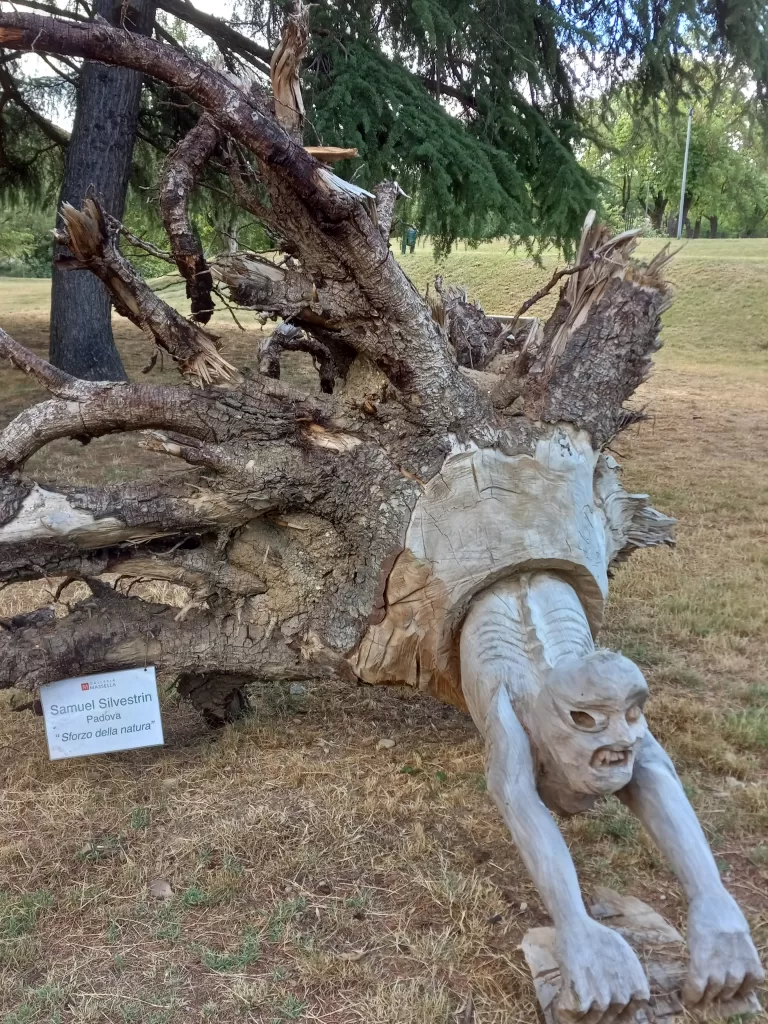
12. Day trips from Verona
Because Verona is so well connected by railways and highways, it is a great hub for making day trips to many interesting locations. The following places are definitely worth a visit:
- Day trip to Sirmione (on Lake Garda) (45 minutes each way by bus)
- Day trip to Bolzano (90 minutes each way by train)
- Day trip to Vicenza (25 minutes each way by train)
- Day trip to Padua (43 minutes each way by train)
- Day trip to Mantua (46 minutes each way by train)
- Day trip to Venezia (72 minutes each way by train)
Side note about Juliette’s balcony:
When my wife and I were in Verona in 2019 we stopped to see what some guidebooks claim is “Juliette’s balcony”. We knew that Romeo and Juliette were simply characters in Shakespeare’s play, and possibly only very loosely based on a real couple. Curiosity compelled us to check it out. What we found was a small intimate courtyard with the supposed balcony (actually added to the building in the 20th century). But we were pleasantly surprised to see the courtyard walls covered with love letters from visitors. There was something very touching about this and very romantic. It gave us a very warm feeling of well being. We returned to Verona in 2022 and went to see Juliette’s courtyard again. But we were shocked to find that all the love letters had been removed and the courtyard walls washed clean. Alas, what had been a wonderful, touching courtyard now feels barren. It is no longer worth a visit.
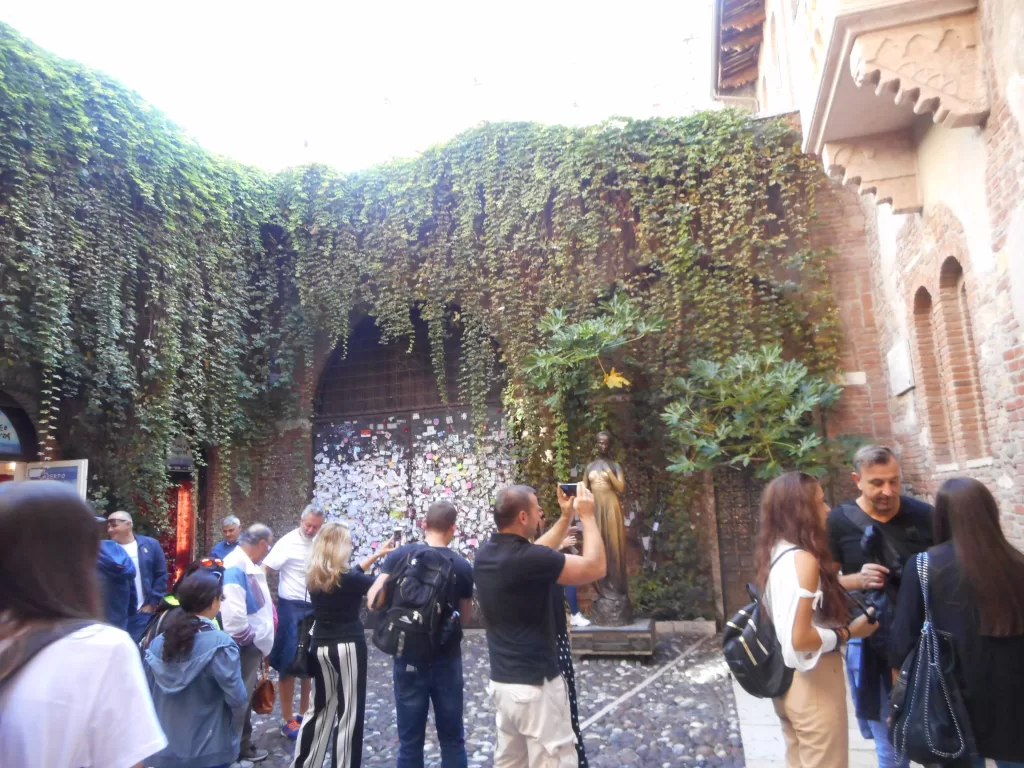
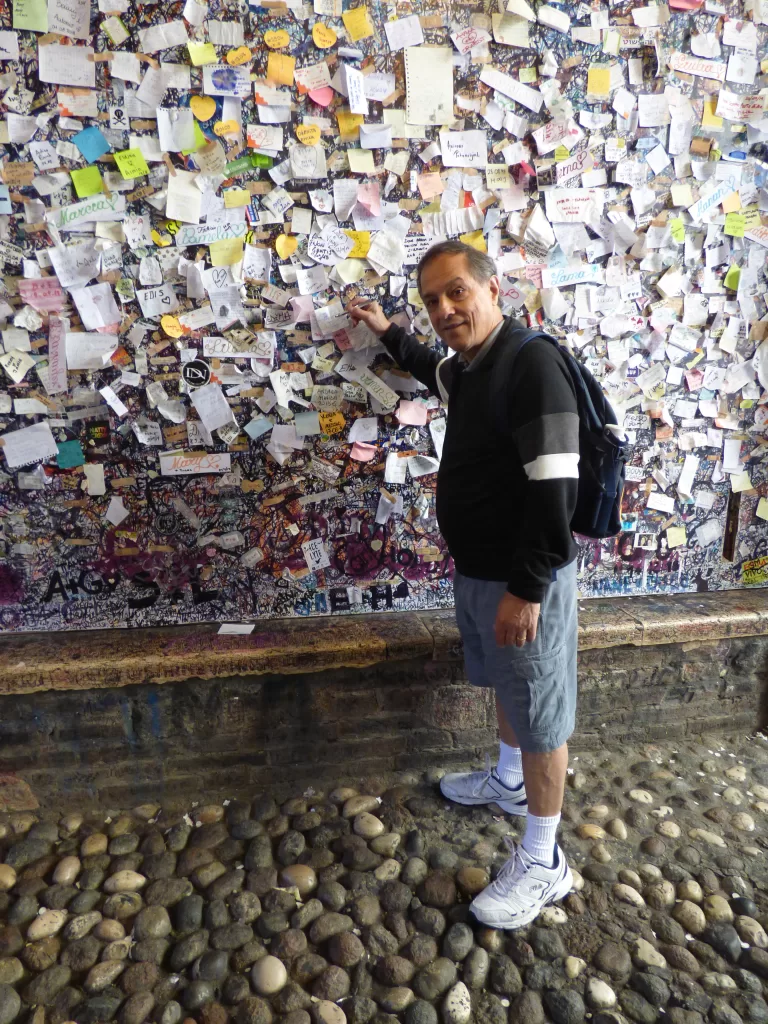
Tourist information office:
The tourist information office information office is located in a side room of the Palazzo Barbieri building (the city government building). The entrance is on the side of the building and faces the arena and the intersection of Piazzetta Municipio and Via Leoncino. The office provides free maps and excellent information about local and some long distance buses.
Restaurants, etc.:
Stay away from the restaurants on the main piazzas. Although they will have good food they tend to be very expensive. Look for restaurants in the side streets. They will offer tasty dishes at reasonable prices.
Restaurants:
Ostregheteria Sottoriva, Via Sottoriva, 23, 37121 Verona, VR, Italy
Pizzeria Leon D’Oro, Via Pallone, 10A, 37121 Verona VR, Italy
Focaccia & Pizza take-out:
Focacceria Genovese, Via Ponte Pietra, 17a, 37121 Verona VR, Italy
Gelato:
Gelateria Savoia Verona, Via Roma, 1/B, 37121 Verona VR, Italy
Train and Bus Information:
- The Verona train station (Stazione Verona Porta Nuova) is located 1 mile south-southwest of Piazza Bra (approximately a 20-25 minute walk).
- The bus station is located next to the train station. (You can’t miss it. Outside the bus station you will see several buses arriving or waiting to depart.)
- You can see schedules and buy tickets at the bus and train stations or you can use one of the following apps or web sites:
(buses and trains) www.rome2rio.com or Rome2Rio app
(mostly trains but also some buses) www.trainline.com or trainline app

